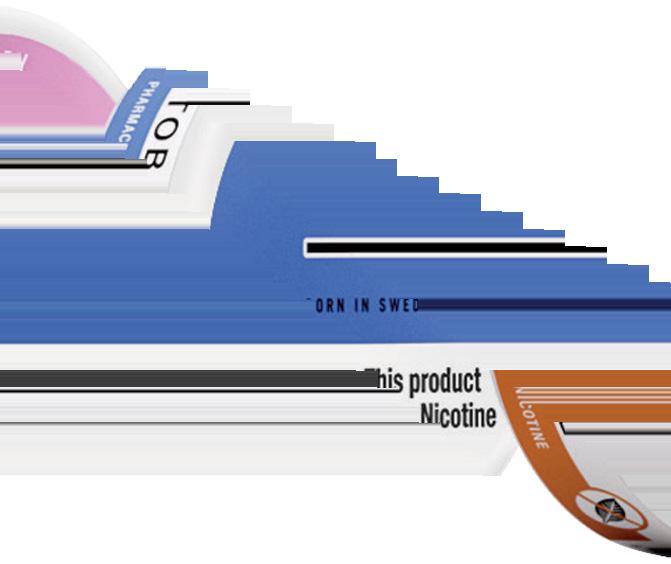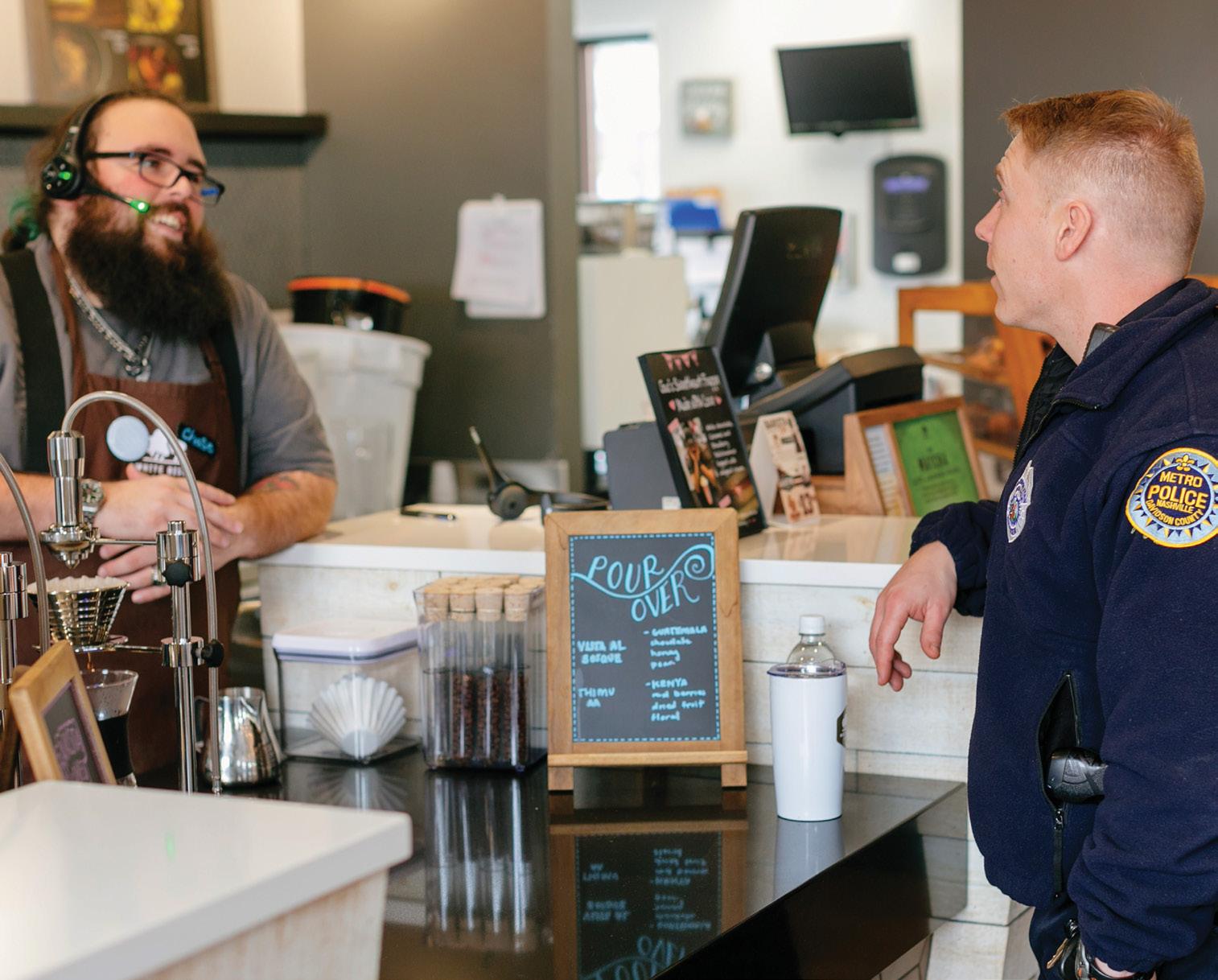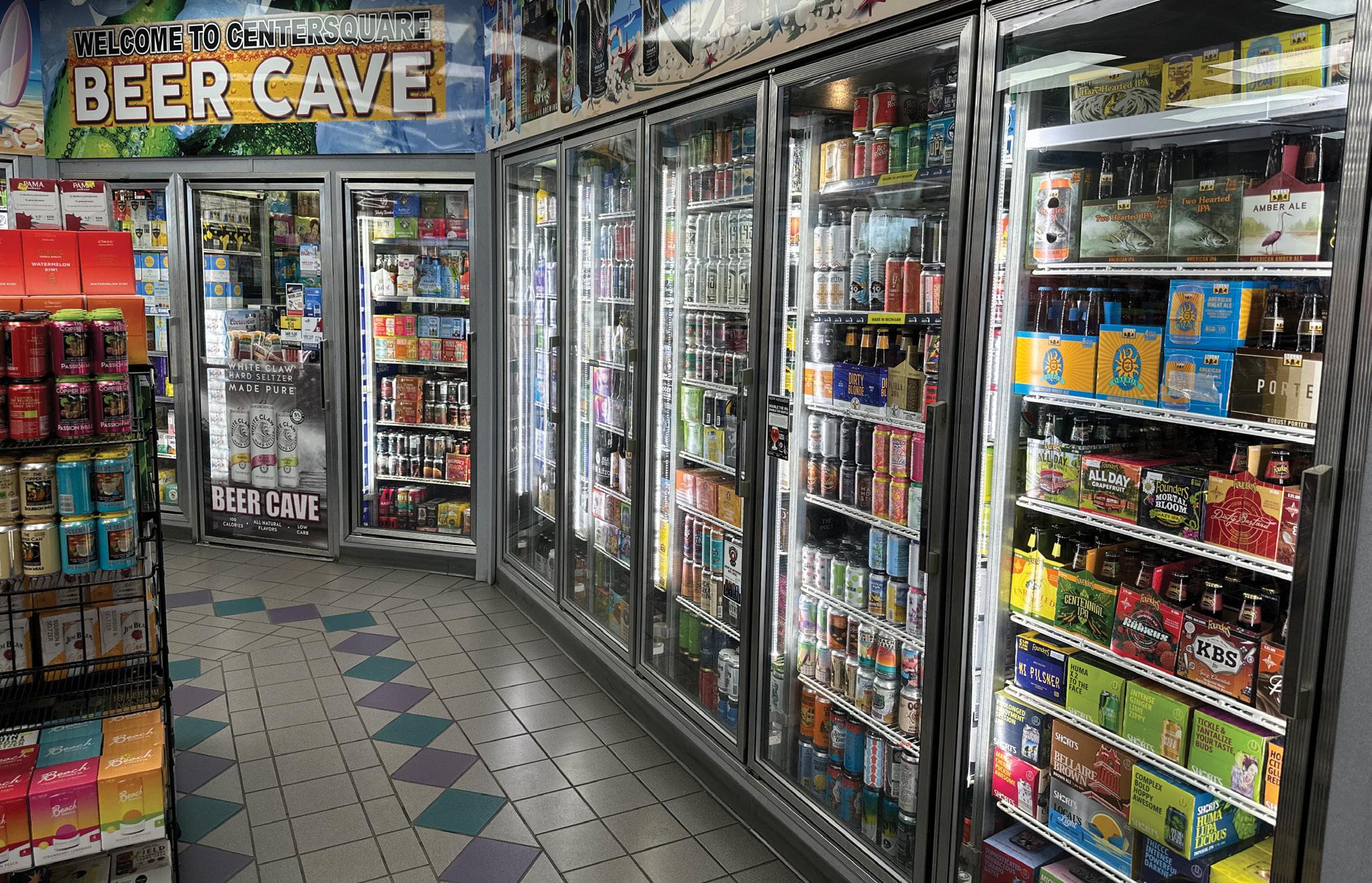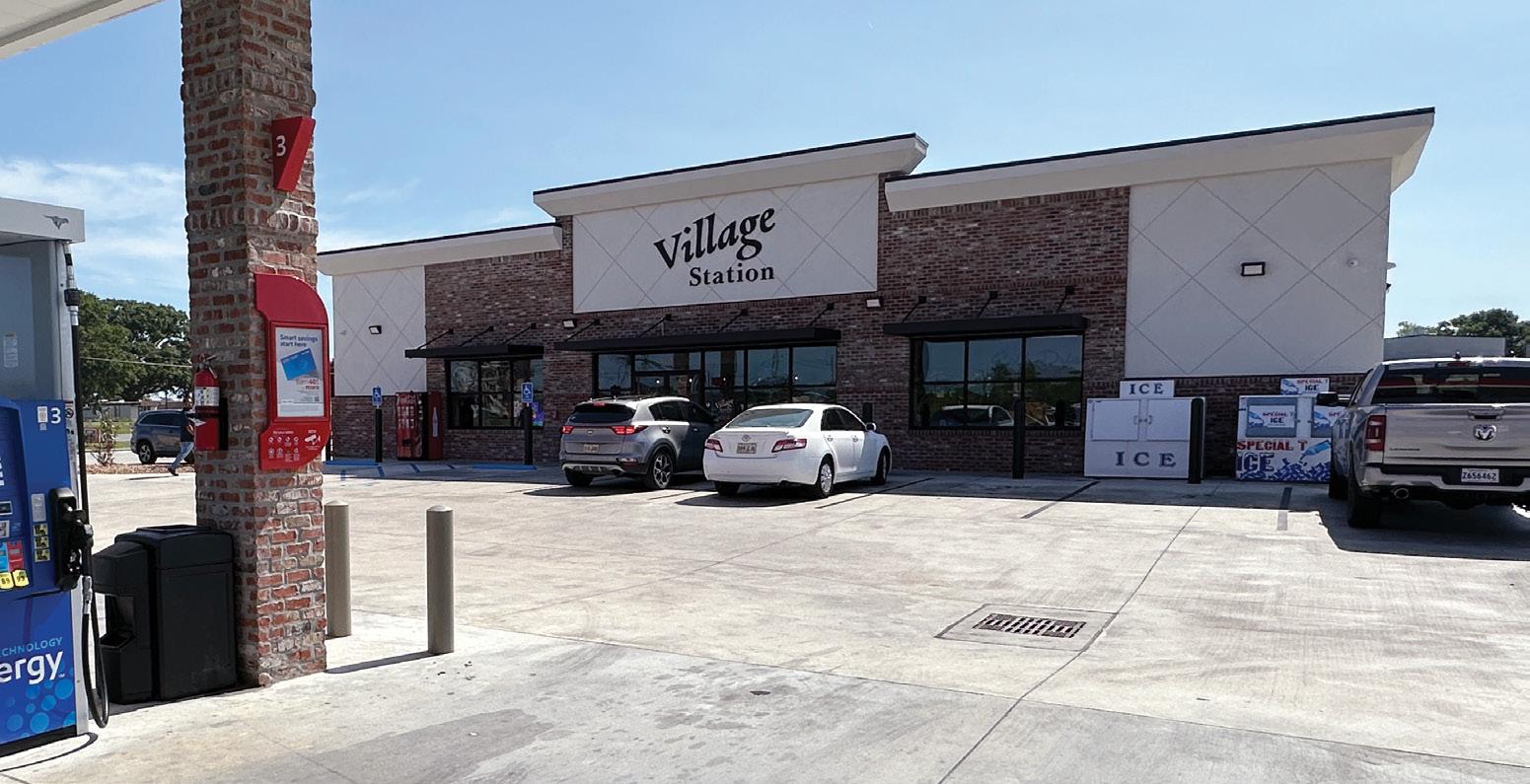











View From Conexxus:
Next Generation of
At the Conexxus Annual Conference, the industry’s sharpest minds peer into the future of technology.
at www.convenience.org/NACSdaily













View From Conexxus:
Next Generation of
At the Conexxus Annual Conference, the industry’s sharpest minds peer into the future of technology.
at www.convenience.org/NACSdaily

A FACT $6,224
The average sales per store, per month of commissary in 2023.

06 From the Editor 08 The Big Question
NACS News
16 Convenience Cares
18 Inside Washington Small businesses could be affected by expiring tax provisions next year unless Congress acts.
22 Ideas 2 Go Center Square prides itself on having the largest variety of drinks in the area.
60 Cool New Products
64 Gas Station Gourmet Affordable, freshmade comfort food is at the heart of this Louisiana c-store.
66 Category Close-Up Commissary foodservice benefits c-stores by reducing labor and food safety concerns.
72 By the Numbers

Polar King walk-in coolers and freezers offer stateof-the-art refrigeration solutions for the convenience store industry. Perfectly designed to meet the unique demands of retail environments, these units provide reliable, efficient storage for perishable goods. ach Polar King unit is constructed with a seamless fiberglass design that ensures outstanding insulation and durability, resulting in energy savings and reduced operational costs.



Polar King offers customizable walk-in coolers and freezers, which allows store owners to design a layout that maximizes the use of space according to their specific needs. By efficiently organizing products, stores can improve customer flow and increase sales.
Polar King's innovative approach to walk-in coolers and freezers offers convenient stores a reliable, efficient, and custom-fit solution to their refrigeration needs. With these benefits and features, store owners can not only preserve their inventory but also enhance their daily operations and customer satisfaction.




EDITORIAL
Jeff Lenard V.P. Strategic Industry Initiatives (703)518-4272 jlenard@convenience.org
Ben Nussbaum Editor-in-Chief (703) 518-4248 bnussbaum@convenience.org
Leah Ash Editor/Writer lash@convenience.org
Lauren Shanesy Editor/Writer lshanesy@convenience.org
CONTRIBUTING WRITERS
Terri Allan, Chrissy Blasinsky, Shannon Carroll, Sarah Hamaker, Al Hebert, Keith Reid, Adam Rosenblatt, Emma Tainter
DESIGN MX www.themxgroup.com
ADVERTISING
Stacey Dodge Advertising Director/ Southeast (703) 518-4211 sdodge@convenience.org
Jennifer Nichols Leidich National Advertising Manager/Northeast (703) 518-4276 jleidich@convenience.org
Ted Asprooth National Sales Manager/ Midwest, West (703) 518-4277 tasprooth@convenience.org
PUBLISHING
Stephanie Sikorski Vice President, Marketing (703) 518-4231 ssikorski@convenience.org
Nancy Pappas Marketing Director (703) 518-4290 npappas@convenience.org
Logan Dion Digital Media and Ad Trafficker (703) 864-3600 ldion@convenience.org
CHAIR: Victor Paterno Philippine Seven Corp. dba 7-Eleven Convenience Store
OFFICERS: Lisa Dell’Alba Square One Markets Inc.; Annie Gauthier, St. Romain Oil Company LLC; Chuck Maggelet, Maverik Inc.; Don Rhoads, The Convenience Group LLC; Brian Hannasch, Alimentation Couche-Tard Inc.; Varish Goyal, Loop Neighborhood Markets; Lonnie McQuirter, 36 Lyn Refuel Station; Charlie McIlvaine, Coen Markets Inc.
PAST CHAIRS: Don Rhoads, The Convenience Group LLC; Jared Scheeler, The Hub Convenience Stores Inc.
MEMBERS: Chris Bambury, Bambury Inc.; Tom Brennan, Casey’s; Frederic Chaveyriat MAPCO Express Inc.; Andrew Clyde, Murphy USA; George Fournier, EG America LLC Terry Gallagher, Gasamat Oil/Smoker Friendly;
NACS SUPPLIER BOARD
CHAIR: David Charles, Cash Depot
CHAIR-ELECT: Vito Maurici, McLane Company Inc.
VICE CHAIRS: Josh Halpern, JRS Hospitality/BCIP dba Big Chicken; Bryan Morrow, PepsiCo Inc.; Kevin LeMoyne, Coca-Cola Company
PAST CHAIRS: Kevin Farley, W. Capra; Brent Cotten, The Hershey Company; Drew Mize, PDI
MEMBERS: Tony Battaglia, Tropicana Brands Group; Patricia Coe Advantage Solutions; Jerry Cutler, InComm Payments; Jack Dickinson, Dover Corporation; Matt Domingo Reynolds; Mark Falconi,
Raymond M. Huff, HJB Convenience Corp. dba Russell’s Convenience; John Jackson, Jackson Food Stores Inc.; Ina (Missy) Matthews Childers Oil Co.; Brian McCarthy, Blarney Castle Oil Co.; Tony Miller, Delek US; Natalie Morhous, RaceTrac Inc.; Jigar Patel, FASTIME; Robert Razowsky, Rmarts LLC; Kristin Seabrook, Pilot Travel Centers LLC; Babir Sultan, FavTrip; Richard Wood III, Wawa Inc.
SUPPLIER BOARD REPRESENTATIVES: David Charles Sr., Cash Depot; Vito Maurici, McLane Company Inc.
STAFF LIAISON: Henry Armour, NACS
GENERAL COUNSEL: Doug Kantor, NACS
Greenridge Natural; Ramona Giderof, Diageo Beer; Mike Gilroy, Mars Wrigley; Danielle Holloway, Altria Group Distribution Company; Jim Hughes, Krispy Krunchy Foods LLC; Kevin Kraft, Q Mixers; Jay Nelson, Excel Tire Gauge; Nick Paich, GSTV; Sarah Vilim, Keurig Dr Pepper
RETAIL BOARD
REPRESENTATIVES: Scott E. Hartman, Rutter’s; Kevin Smartt, TXB; Tom Brennan Casey’s
STAFF LIAISON: Bob Hughes NACS
SUPPLIER BOARD
NOMINATING CHAIR: Kevin Martello, Keurig Dr Pepper
NACS Magazine (ISSN 1939-4780) is published monthly by the National Association of Convenience Stores (NACS), Alexandria, Virginia, USA.
Subscriptions are included in the dues paid by NACS member companies. Subscriptions are also available to qualified recipients. The publisher reserves the right to limit the number of free subscriptions and to set related qualifications criteria.
Subscription requests: nacsmagazine@convenience.org
POSTMASTER: Send address changes to NACS Magazine, 1600 Duke Street, Alexandria, VA, 22314-2792 USA.
Contents © 2023 by the National Association of Convenience Stores. Periodicals postage paid at Alexandria VA and additional mailing offices. 1600 Duke Street, Alexandria, VA 22314-2792




















Premier Manufacturing is excited to introduce NIC-S®. Premium tobacco-free nicotine pouches backed by extensive scientific research, made with pharmaceutical grade nicotine, and is setting a higher standard for nicotine pouches.


PHARMACEUTICAL GRADE NICOTINE









6 FLAVOR PROFILES WITH 3 STRENGTHS (3MG, 6MG, AND 9MG)






EXTENDED NICOTINE RELEASE


LONG LASTING FLAVOR
PREMIUM SOFT POUCHES











































































































The NACS Foundation’s annual 24/7 Day (which takes place July 24) is a way for c-stores to thank first responders and anyone else who is on the clock around the clock, but it’s also more than that. More than two and half million people work in the U.S. c-store industry, and a bunch of those people are working right now—even if you’re reading this in the middle of the night.
By staying open overnight, our stores are beacons of safety and hospitality to whoever needs it, whenever they need it, including first responders and other essential workers.
We don’t necessarily celebrate the frontline workers who take overnight shifts—not to mention the owners or managers who sleep with a phone by their bed, ready to be called into action if they’re needed. But they are essential, too, and need to know that they’re essential. By participating in 24/7 Day, retailers put a mirror in front of their own workers, letting them see the role they play.

More than 30,000 convenience store locations participated in 24/7 Day in 2023.
retailing. Keith Reid, editor in chief of Fuels Market News Magazine, did the heavy lifting for these articles.
It’s not too late to participate in this year’s 24/7 Day event. Read our The Big Question interview with Stephanie Sikorski on page 8 for more information. Elsewhere in this issue, we focus on fueling, with a look at the possible low-carbon liquid fuels of the future and overviews of two NACS State of the Industry Summit presentations: One on EVs and one on the current state of fuel
Also be sure to check out our report from the annual Conexxus conference. It’s a safe bet that the c-store experience will be very different in a decade, not just for customers but also for everyone involved in the industry. Conexxus gathers some of the best minds in the industry to lay out potential futures and when and how different technologies will come online.
Got any story ideas? Feedback? Drop me a note at bnussbaum@convenience.org.

Ben Nussbaum Editor-in-Chief

The NACS Foundation’s 24/7 Day initiative began six years ago. We walked through different ways that we can better support each other as an industry and what we could do better for the communities we serve. We knew that historically, it has been written in the news that nothing good happens after ‘zero dark thirty.’
Instead of chasing down and reacting to those headlines, we decided to lean into them. What if we took it upon ourselves to help change that narrative for our industry?
We all know that first responders work around the clock. You’ve got police, firefighters, medical personnel, 911 dispatchers and emergency professionals and more. When Covid happened, we talked about the doctors, nurses and paramedics, and how at two o’clock in the morning, convenience stores might be the only place that’s open for them as they either start their shift or end it.
Natural disasters—and disasters, period—happen all across the United States. A lot of the time, our stores are the first place people go to when coming back to a community or the last place people stop to fill up, hit the ATM or grab a bottle of water as they’re leaving harm’s way. In fact, many times convenience stores are the only places that are open.
So, 24/7 Day leans into the idea that convenience stores are the unspoken first supporters of first responders. That’s a pretty powerful story to tell and we wanted to share it loudly.

Stephanie Sikorski, executive director, NACS Foundation; vice president of marketing, NACS
Participation can be as small as promoting a cup of coffee that you’re already giving to first responders. It could be a check donation to the American Red Cross, or other hyperlocal response relief charity. It could be a hot food offer. It might be giving lunches to a local fire station. Saying thanks can come in a lot of different formats.
We truly try to make this as plug-and-play as possible so that operators of all sizes can participate in whatever way is authentic to them, their brand and their communities. The support from the supplier community is also very strong. In six short years, this event has brought together thousands of people from across the c-store ecosystem in a way we never anticipated.
I love to see the stories where the police, firefighters, 911 professionals and disaster response volunteers are saying ‘Thanks so much’ to fill-in-the-blank store. What I hear from them is “I feel seen” or “thank you for seeing me.” It’s powerful to see those first responders that are coming right back to thank the convenience store operators and their teams.
The other thing that we didn’t think about necessarily was the response that retailers are seeing from their employees, who appreciate being part of this. We’re all human, right? We all want to work for companies that have heart and do good things. And an act of kindness doesn’t have to cost a lot. Sometimes it’s just as easy as saying ‘thanks.’
is a celebration of first responders and everyone who works around the clock to serve our communities to ensure people don’t face emergencies alone. It’s also our industry’s way of highlighting that convenience retail frontline workers offer hospitality and support when it’s needed most. The event takes place every year on July 24. To learn more, email conveniencecares@convenience.org or visit 247day.org.

The future’s looking up for adult tobacco and nicotine consumers looking for spit-free, smoke-free nicotine satisfaction. ZYN makes 23 of the nation’s top 25 selling nicotine pouches which makes your top shelf the most logical place to find it.

If there’s one event you don’t want to miss this year, it’s the convenience industry’s biggest global gathering—the NACS Show. The Show is returning to Las Vegas this year from October 7-10, with the Expo opening October 8.
With more than 20,000 expected attendees, industry members will learn from each other, discover the latest products and innovations and gather information on top industry trends from approximately 50 education sessions. Be sure to check out:
• The Expo: There’s more than 430,000 square feet of Expo space to explore, featuring more than 1,200 exhibi-
tors across five categories: Facility Development & Store Operations, Food Equipment & Foodservice Programs, Fuel Equipment & Services, In-Store Merchandise and Technology.
• The Cool New Products Room: This exclusive space showcases the latest products and innovations shaping the industry. The Preview Room is a must for anyone launching a new product into the convenience channel. Retailer attendees can scan hundreds of new products to create their own shopping list for the Expo floor.
• The New Exhibitor Area: A section that highlights the latest technology,
products and companies entering the convenience store market.
• Education Sessions: These learning opportunities will ignite your competitive edge as you hear from leading industry peers. The robust lineup will address industry hot-button issues and give you the opportunity to expand your knowledge and develop expertise in the areas that matter the most to you.
Full conference registration includes access to all general sessions, education sessions, the Expo and the official NACS Show Kick-Off Party on October 7. Visit NACSshow.com to register.

Co-located with the 2024 NACS Show in Las Vegas, the NACS Food Safety Forum will return for its third year on October 7. Why should you attend? Because food safety is not an option—it’s an imperative.
Convenience stores are one of the fastest growing food segments, with foodservice (prepared food; commissary; hot, cold and frozen dispensed beverages) representing nearly 27% of inside sales in 2023, according to NACS State of the Industry Report® data.
The half-day forum aims to empower convenience leaders and their teams to do the right thing, protect public health and brands and deliver the high quality and safe experience customers deserve.
Content at this year’s Forum will focus on four main principles: consumer safety, clean and quality experiences, protecting our brands, and empowering our teams to do the right thing. The lineup includes sessions and panels on:
• State of Foodservice in Convenience, featuring Chris Rapanick, managing director, NACS Research
• Testing Your Temperature Monitoring, Cleaning and Sanitation IQ, featuring David McIntyre, senior health and safety specialist, EG Group
• Top Food Safety Risk Factors
• Solutions for Protecting Public Health Panel, featuring Melanie Harris, manager, food safety retail, Casey’s; Corrin Howard, senior regulatory compliance supervisor, Wawa; and moderator Jeremy Zenlea, vice president health and safety, EG America
Additionally, participants will be empowered to recognize the whys behind food safety protocols and how certain behaviors can enhance and protect their teams, customers and brands.
Register for the 2024 Food Safety Forum at convenience.org/FSF
Harnessing data, successfully harnessing AI and charging ahead in the c-store industry with confidence were themes that came out of this year’s Conexxus Annual Conference, held April 28-May 2 in Arlington, Texas.
The event brought together convenience industry thought leaders focused on innovations in technology that drive the industry forward. With education sessions on forward-thinking technology topics including how to thrive on the unknown frontier of AI, how to navigate industry disruptions on the horizon, strategies for the EMV payment chip transition and how to harness emerging digital technologies, the conference underscored Conexxus’ mission to help convenience and fuel retailers solve unique technology challenges, implement technology standards and drive profitability.
Read more about the key takeaways from the 2024 conference elsewhere in this issue. The 2025 Conexxus Annual Conference will take place January 26-30 in Tucson, Arizona.
Aside from the annual conference, there’s much insight to be gleaned from Conexxus events, resources like monthly Conexxus365 webinars and the organization’s around-the-clock work on our industry’s technology standards. Ongoing committee work currently focuses on hot topics such as mobile payments, forecourt device controllers and payment terminals, POS/back office systems and interfaces, third-party delivery services, data security and privacy. At the same time, the Innovation Research Committee is focused on key retailer initiatives.
Gray Taylor, executive director of Conexxus, welcomed attendees to the annual conference.

Conexxus will also hold its Annual Strategy Conference this August 19-22 in Boise, Idaho, where Conexxus leaders and staff and members will gather to discuss the strategies and key initiatives that will drive the technology standards work in the year ahead. Retailers can also attend the Conexxus Retailer Field Trip to the University of Florida Loss Prevention Research Center, November 7-8, in Gainesville, Florida.
And when you’re planning your schedule at this year’s NACS Show in October, make sure to drop by the Conexxus show floor booth (#C6110) and hear insights from Conexxus staff members during several education sessions that will help you stay ahead of the curve, including “A New Dimension in Barcodes?! Preparing for Sunrise 2027” and a presentation on the Conexxus Technology Roadmap, which “peers a decade into the future to outline technological and cultural shifts that will shape the evolving landscape.”
Visit conexxus.org or email info@conexxus.org for more information.

Gary Hoogeveen was appointed president of Pilot. As president of Pilot Energy, Hoogeveen will oversee the company’s integrated fuel supply chain, including upstream infrastructure and asset management, business development, fuel procurement, logistics and transportation. In addition, he will steward the ongoing development and innovation of electric and alternative energy solutions. Prior to joining Pilot, Hoogeveen most recently served as chief executive officer of Rocky Mountain Power. He has held several management roles as part of Berkshire Hathaway Energy since 2000. Hoogeveen earned a Bachelor of Science degree in physics from the University of Northern Iowa and a Ph.D. in space physics from Rice University.
Smoker Friendly named Dan Gallagher as its new president. Dan has acted as executive vice president and chief operating officer at the retail tobacco and fuel company for more than 32 years and will continue his duties as COO while serving as president. His predecessor Terry Gallagher, Jr. previously served as president, CEO and chairman of the board since the establishment of TCS LLC in 1991. Terry will remain at Smoker Friendly in his positions as CEO and chairman of the board.

William Lin will now lead the gas and low carbon energy business at BP, succeeding Anja-Isabel Dotzenrath who is retiring from BP and her executive career. Lin previously led regions, corporates and solutions at BP for the past four years. Lin has worked at BP for 28 years, holding senior management roles across the world including in Asia Pacific, Egypt and the United States, and has served as head of BP’s group chief executive office and as chief operating officer in the former Upstream responsible for all oil and gas regions across the portfolio.

BP also announced that Emeka Emembolu will lead BP’s technology function. Emembolu has worked as chief of staff for the past two years. In this role he ran the CEO office and provided direct support and advice to the BP leadership team. Emeka has been with BP for 25 years, starting his career working offshore as an engineer. Before joining the executive office, Emembolu ran BP’s business in the North Sea.
István Kapitány is stepping down from his position as global executive vice president of Shell Mobility, effective July 1. Kapitany took on his current role in 2014. Since then, he’s helped grow Shell’s mobility business to more than 500,000 people and over 45,000 retail outlets in 85 countries.

Maria Jelescu Dreyfus has joined ExxonMobil’s board of directors. Dreyfus is CEO and founder of Ardinall Investment Management, an investment firm focused on sustainable investing and resilient infrastructure. Prior to forming Ardinall in 2017, Ms. Dreyfus spent 15 years at Goldman Sachs, where she was a portfolio manager and managing director in the Goldman Sachs Investment Partners Group focusing on energy, industrials, transportation and infrastructure investments across the capital structure, in both public and private markets.


NACS welcomes the following companies that joined the Association in April 2024. NACS membership is company-wide, so we encourage employees of member companies to create a username by visiting convenience.org/ create-login. All members receive access to the NACS Online Membership directory and the latest industry news, information and resources. For more information about NACS membership, visit convenience.org/membership.
RETAILERS
Atkinsons Gas
Eagle Canyon Capital LLC San Ramon, CA
ExtraMile Convenience Stores LLC dba ExtraMile Pleasanton, CA Chevronextramile.com
Millwood Market East Norwich, NY
Rapid Robert’s www.rapidrobertsinc.com
Super Quik Inc. Flatwoods, KY www.superquik.net
TyKo Gas & Go Kanab, UT
NACS Global Supplier Council
Techniche Carlsbad, CA www.technichegroup.com
SUPPLIERS
ABB E-Mobility Cary, NC e-mobility.abb.com
Alpine Net Corporation South Plainfield, NJ www.alpinenetcorp.com
Axxis Software (part of OPIS) St. Paul, MN www.axxispetro.com
Breakthru Beverage Cicero, IL www.breakthrubev.com
BrewDog Canal Winchester, OH
Casa Sabor LLC Conroe, TX www.casa-sabor.com
Cassida Corporation San Diego, CA
Clio Snacks Piscataway, NJ cliosnacks.com
Creative Display Works Inc. Phoenix, AZ www.creativedisplayworks.com
Emotional Utility Beverage Beverly Hills, CA Drinkeub.com
Epson America Inc. Long Beach, CA www.pos.epson.com
2024
OCTOBER
NACS Show
October 07-10 | Las Vegas Convention Center Las Vegas, Nevada
NOVEMBER
NACS Innovation Leadership Program at MIT
November 03-08 | MIT Sloan School of Management Cambridge, Massachusetts
NACS Women's Leadership Program at Yale
November 17-22 | Yale School of Management New Haven, Connecticut
2025
JANUARY
Conexxus Annual Conference January 26-30 | Loews Ventana Canyon Tucson, Arizona
FEBRUARY
NACS Leadership Forum February 11-13 | The Ritz-Carlton Amelia Island, Florida
NACS Convenience Summit Asia February 25-27 | Conrad Tokyo Tokyo, Japan
Imaginings 3 Flix Candy Niles, IL
Luxiikon Inc. Beverly Hills, CA
Motion Technologies Inc. Phoenix, AZ www.motiontechnologies.com
Ohserase Manufacturing Hogansburg, NY www.signaltobacco.com
Panasonic Newark, NJ www.panasonic.com/cmo
Quikturn Professional Screenprinting Inc. Placentia, CA quikturnusa.com
Shields, Harper & Co. Martinez, CA www.shieldsharper.com
Standard AI San Francisco, CA www.standard.ai
SugarCreek Packing Co Blue Ash, OH www.sugarcreek.com
MARCH
NACS Day on the Hill March 10-12 Washington, D.C.
NACS Human Resources Forum March 24-26 | Hutton Hotel Nashville, Tennessee
APRIL
NACS State of the Industry Summit April 08-10 | Hyatt Regency DFW International Airport Dallas, Texas
For a full listing of events and information, visit www.convenience.org/events.





Verifone is excited to provide the most advanced digital age verification solution available to its convenience retail customers.
Built by NACS, for the industry by the industry, TruAge helps protect all aspects of your business–your brand, your employees and your bottom line. Now available to all Verifone retailers running Release 54 or higher.



Start for FREE — No “swipe fees” or extra costs for age verification.
Protect Your Staff & Store — Verify age and log proof, reducing the risk of selling to minors.
Protect Customer Privacy — TruAge uses only birthdate, license number, state, and expiration date; no personal data is collected.
Stay Compliant — TruAge updates legal and manufacturer requirements to ensure compliance.
Reduce Underage Access — Reliably detect fake IDs, restricting youth access to age-restricted products.

The retailer donated 10% of profits from its Memorial Day fuel promotion to the nonprofit.
Circle K donated $313,484 to the Children of Fallen Patriots Foundation with funds collected from its Memorial Day fuel sales and other events. The foundation honors the sacrifices of fallen military heroes by providing college education, scholarships and educational counseling to children who have lost a parent in the line of duty.
The retailer donated 10% of the profits from fuel sales during its Circle K Fuel Day event on May 23, totaling $260,000. The promotion was held at over 5,500 stores nationwide and offered 40 cents off per gallon of fuel between 4 p.m. and 7 p.m. on the day of the event.
Additionally, Circle K partnered with the charity and PepsiCo to support its Rolling Remembrance tour in April, amplifying the Children of Fallen Patriots Foundation and its mission by donating $50,000 to the cause. Now in its ninth year, Rolling Remembrance has raised
more than $2 million for the Children of Fallen Patriots Foundation, providing more than 320 years of college for their scholars.
“We are proud that our recent Fuel Day supported an amazing and deserving organization like Children of Fallen Patriots Foundation,” Louise Warner, sr. vice president for global fuels at Circle K, said in a company press release. “We have many employees who are veterans, so this cause is near and dear to our company, and one that our teams were proud to rally around as we observed Memorial Day.”
The retailer said the total donation amount will provide more than 50 years of college for Children of Fallen Patriots scholars. Circle K presented the donation in San Antonio, a community with deep military roots and more than 150 Circle K stores, on May 31 with the help of San Antonio basketball legend and veteran David “The Admiral” Robinson.
Every year, the convenience retail industry dedicates billions of dollars to advancing the futures of individuals and families in our communities.
The NACS Foundation unifies and builds on NACS members’ charitable efforts to amplify their work in communities across America and to share these powerful stories.
Learn more at www.conveniencecares.org
1 Ankeny, Iowa-based Casey’s immediately sprang into action following a series of devastating tornadoes that ripped across the Midwest in April, launching a roundup campaign to support the American Red Cross at Casey’s stores across Iowa, Nebraska and Oklahoma. The retailer also made a $10,000 donation directly to the humanitarian organization to help pick up the pieces of local communities devastated by the storms.
At the end of May, the convenience retailer announced that with the help of its generous guests, Casey’s was able to donate $100,000 to the American Red Cross to aid in response and recovery efforts.
2 Wawa and The Wawa Foundation have raised more than $160 million in donations to causes supporting health, hunger and everyday heroes.
The milestone comes 10 years after the Foundation’s inception.
Since its inception in 2014, Wawa and The Wawa Foundation have impacted more than 6,500 organizations across the communities Wawa serves. In addition, they have donated more than 35 million meals from Wawa stores to local food pantries through the Wawa Share Food Donation Program.
3 Following its initiative in support of asthma research, Valor Oil’s HOP Shops raised $25,000 for the Jovante Woods Foundation. In addition to supporting asthma research, the Jovante Woods Foundation’s goal is to raise awareness about the disease and its dangers while advocating for better treatments. The foundation’s efforts are crucial in addressing the challenges faced by individuals living with asthma and driving progress towards finding a cure.
“We believe in the importance of raising awareness and supporting research efforts to combat diseases like asthma,” said Damon Bail, vice president of retail operations. “The funds raised will contribute to the foundation’s mission of advancing medical research and developing more effective treatments to improve the lives of those affected by asthma.”


4 The Town Pump Charitable Foundation awarded 116 libraries in 105 Montana communities with Keep Kids Reading grants in the amount of $1,000 each to support their 2024 summer reading programs. “The Town Pump Charitable Foundation appreciates the critical role libraries play in our Montana communities,” said Bill McGladdery, director of corporate communications for Town Pump. “Many Montana libraries increase youth-reading programs in the summer months to help prevent the ‘summer slide’ and help children maintain or improve their spelling, vocabulary and comprehension skills.”
5 In honor of Military Appreciation Month in May, Yesway donated $100,000 to Operation Homefront to support military personnel and first responders. The retailer also encouraged its customers to donate to Operation Homefront at Yesway and Allsup’s stores through in-store purchases or Smile Rewards donations throughout the month. The company donated 10 cents to Operation Homefront for every purchase of a Body Armor 28-ounce or one-liter beverage, or any Yesway or Allsup’s private-label brand salty snack.

6 In April, 7-Eleven held its 7Cares Day where employees from the Irving, Texas, and Enon, Ohio, Store Support Centers volunteered with local non-profit organizations. In Texas, 289 volunteers from 7-Eleven provided over 722 hours of service in the community and raised $12,000 in donations, working with impactful non-profits such as Bonton Farms, Children’s Health Plano, Equest Therapeutic Riding Therapy, Minnie’s Food Pantry, North Texas Food Bank and Team Rubicon.
In Ohio, 130 volunteers provided over 325 hours of service and contributed $8,000 in donations, working with non-profit organizations such as Dayton Children’s Hospital, Finally Home Farms, Rebuilding Together Dayton and Springfield Promise Community Garden.
7 OnCue partnered with Positive Tomorrows, an Oklahoma-based school and social services agency for children and families experiencing homelessness. From January to March of this year, OnCue’s charitable cup program raised $15,000 for Positive Tomorrows. To mark this achievement, the OnCue team spent a morning volunteering at the school, engaging with students over breakfast and sharing in outdoor playtime.




BY JON TAETS
It’s often said that Congress doesn’t do much unless it’s coming up on a deadline. And we are likely to see that notion in full effect next year as many of the individual and small business-oriented tax provisions of the 2017 Tax Cuts and Jobs Act (TCJA) are scheduled to expire at the end of 2025.
Back when legislators were drafting the bill, they had to make certain concessions on the overall cost of the package to use the fast-track method known as reconciliation. Reconciliation allows for legislation that has a significant budgetary impact to pass the Senate by a simple majority, rather than being subject to a 60-vote threshold or filibuster. However, in exchange for that fast-track authority it must stay within a total cost constraint set by a budget resolution,
and it must not cause deficits beyond a 10-year window as calculated by the Congressional Budget Office (CBO).
As Congress prioritized making the corporate tax rate in the United States permanently more competitive on a global scale, they chose to offset that cost by ending the reduced taxes on individuals and small businesses after only seven years. By CBO’s math that meant the law would not run afoul of either requirement.
With almost all taxpayers in the United States facing a 2% to 3% increase in their individual taxes in 2026, Congress is likely to take some kind of significant action to forestall that increase before the end of 2025. Though if you are hoping for it be done early in 2025, don’t hold your breath.

Americans are also looking at losing the significantly higher standard deduction, which simplified tax filings for millions. They’re also facing higher thresholds on death tax liabilities and increases in capital gains and other investment taxes, among other tax hikes.

The fact that all House Members and one-third of the Senate will be facing voters just seven months after those taxes would be due all but guarantees they will scramble together some kind of fix.
Small businesses, like most convenience stores, may face the worst
outcome should Congress not act. One of the biggest benefits to family businesses, which operate as pass through entities, was the 199A Qualified Business Income Deduction that came from the TCJA. 199A allows for s-corps to immediately deduct 20% of their business income
Small businesses, like most convenience stores, may face the worst outcome should Congress not act.
from their taxes. The deduction is an effort to bring their marginal tax rates closer to parity with c-corps, which saw their tax rate permanently cut to 21% in the TCJA.
Recently, NACS Board of Directors Member and President of HJB Convenience, Raymond Huff, was invited to testify before the House Small Business Committee about the impact losing 199A would have on his business. During his testimony, Huff told the Committee that 199A felt like the first time that tax policy was really aimed at him as a small business owner, and he talked about the significant investments he made into his business that would not have been possible without that particular provision. Some of those investments made it possible for him to keep some stores operating during the pandemic when they may have otherwise been forced to close. Should 199A be allowed to expire, he said he would have to significantly scale back plans to reopen a number of stores in the coming years, taking away jobs from local communities where those stores would be located.
There are several other provisions at risk of expiration in 2025 that small businesses rely on. During his testimony, Huff also talked about the 100% Bonus Depreciation provisions that allowed businesses to deduct the full amount of certain improvement costs immediate-
Huff testified to a Congressional committee that 199A felt like the first time tax policy was really aimed at him as a small business owner.
ly rather than over a period of 15 or 30 years. That provision has already begun to phase out, only allowing 80% deduction last year and 60% this year, and is scheduled to completely phase out in 2027. Likewise, the Work Opportunity Tax Credit (WOTC), used widely in the convenience industry as a benefit to hiring disadvantaged populations, is set to expire at the end of 2025 as well. So what is Congress likely to do? Like so many things in Washington, the answer to that question is largely dependent on the outcome of the 2024 elections. Which party controls the White House and majorities in Congress will tell us a lot about where the 2025 package is likely to head.
Some work on the package is already getting started, however. House Ways and Means Committee Chair Representative Jason Smith (R-MO) has begun establishing small groups of members of his committee to brainstorm different parts of the tax code. Should Republicans retain the majority—and Smith the gavel—he has said it is his intention to have everything on the table as part of this discussion, not just the expiring provisions. Should Democrats wrest the majority in the House, and Rep. Richie Neal (D-MA) or another Democrat take the gavel back, you can likely expect a similar approach where they will want to look at all parts of the tax code. The same is likely true in the Senate.
Republican majorities will be looking to do whatever they can to extend the individual tax provisions, if not make them permanent. It’s even possible they would entertain a small increase in the corporate rate to help make that happen,
though that would certainly not be a guarantee.
A Democratic majority would likely seek to allow the tax rates on higher incomes to increase while protecting the rate for lower- and middle-class taxpayers, while also seeking a potential significant increase in the corporate tax rate and possible additional restrictions on the use of 199A.
The wildcard is who wins the White House. A return of former President
Trump would likely increase the pressure—at least on Republicans in Congress—to protect the TCJA entirely, as Trump views that law as one of the crowning achievements of his term in office. A second Biden Administration would likely be much more open to dismantling parts of that law.
There is a lot on the line for all Americans, but certainly on small businesses as to how Congress chooses to address the expiring provisions of the TCJA next year. Stay tuned throughout the fall and into next year as the outcome will hopefully become a bit clearer.

Jon Taets is NACS director of government relations. He can be reached at jtaets@ convenience.org
NACSPAC was created in 1979 by NACS as the entity through which the association can legally contribute funds to political candidates supportive of our industry’s issues. For more information about NACSPAC and how political action committees (PACs) work, go to www.convenience.org/nacspac. NACSPAC donors who made contributions in May 2024 are:
Matt Domingo Reynolds
Mike Gilroy Mars Wrigley
Josh Halpern
JRS Hospitality / BCIP dba Big Chicken
Julie Jackson
Jackson Advisory & Consulting
Aaron Littlefield Littlefield Oil Company
James McNutt
Midwest Petroleum Company
Nicolas Papadopoulos Verifone, Inc.
Lisa Rountree TruAge
Stanton Sheetz Sheetz, Inc.
Stephen Sheetz Sheetz, Inc.
Rich Spresser Alta Convenience
Melissa Vonder Haar iSee Store Innovations
John Wilson iSee Store Innovations














Name of company:
‘The
Center Square prides itself on having the largest variety of drinks in its area.
BY SARAH HAMAKER
Customers looking to quench their thirst have options at Center Square in Oxford, Michigan. “We have 20 feet of liquor, a walk-in beer cave and 12 beverage cooler doors,” said owner Carlo Koza. “We offer so many different drinks, from the big names to the smaller brands, because the more you offer, the more customers will stay loyal to you when it comes to beverages.”
The Center Square store didn’t always have such an extensive beverage collection. It wasn’t until Koza took over in 2014 that the transformation into a beverage destination began.
The main thing that propelled Koza to purchase the store a decade ago was its 5,000-square-foot size. “The previous owner was ahead of his time with such a large store, which allowed me to increase the beverage selection, among other things,” Koza said.
He immediately applied for a liquor license to add spirits to the beer and wine already being sold. “We’ve become an old-school liquor store and enlarged our beer and wine selections, too,” Koza said. “Beer has expanded like crazy, along with the ready-to-drink seltzer market and classic cocktails already mixed in a can or bottle.”
Koza used his nearly two decades of experience in the convenience store industry to bring in a variety of beverages to slake customers’ thirst. “Carbonated beverages still sell well, and the energy sector is on fire,” he said. “Caffeine is a big thing too, with customers looking to get more caffeine in their systems through energy and soda, while sparkling water and hydration drinks have exploded, too.” In addition, he stocks a lot of carbonated beverage alternatives, such as carbonated natural fruit juices, and a wide selection of sparkling waters.
“Overall, customers are taking to all these new beverage products, and we need to keep up with the new drink products so our customers see us as the place to go to for beverage innovations,” Koza said.
Along with expanding the beverage selection, Koza replaced the two previous franchises with Dunkin’ and Krispy Krunchy Chicken. “The Dunkin’ has a drive-thru, and that has been very popular with our customers, providing great synergy for a gas station,” he said. He also added a 20-foot food counter for Center Square’s own hot food. “Our advantage is two national brands, plus our own hot food, such as daily specials,” he said.

Carlo Koza, owner of Center Square in Oxford, Michigan, sees the future of convenience as food. “If you’re in the c-store business, if you’re not adding food to your convenience stores, you’re going to be trouble,” he said. “You need to be as convenient as you can, and food drives people to your stores.”
He pointed out that “work routes have changed and there are cars on the roads all day, so you need to have different reasons to get them into your store. The classic gas station sold gas, cigarettes and pop, but the ones that are getting bigger and better and stronger today are the ones with more options.”
Beyond its food and beverage offerings, Center Square has more ways to bring in customers. For example, the store offers propane tanks, firewood and charcoal for seasonal visitors to the nearby lakes, along with worms and fishing gear. “We try to have everything people will need from worms to medicine to health and beauty products,” Koza said.
But what Koza has not tried to become is a truck stop with souvenirs and other novelty items. “We’re very neighborhood-ish, with 60-70% of our customers stopping by every day,” he explained. “We tried the novelty stuff like t-shirts, stuffed animals and hats, but those didn’t sell.” Instead he stocks everyday essentials like phone chargers and cords. Center Square builds community through its charitable giving to churches, school events and sports team sponsorships. “It’s important to show the community we care about them beyond having them come into our store,” he said.
Overall, he strives to be the epitome of a convenience powerhouse. “We want you to come in here and pick up your favorite packaged beverage or a cup of Dunkin’ coffee, perhaps grab a salad or fruit cup if you’re in a healthy mood or pizza or fried chicken if you’re not,” Koza said. “We also want to have what every customer needs, especially in the liquor department. In other words, we try to be a mini-Walmart within 5,000 square feet.”
To Koza, big stores are the future of convenience. “The consumer wants variety and innovation, which you need more square footage to provide,” he said.

Sarah Hamaker is a freelance writer, NACS Magazine contributor, and award-winning romantic suspense author based in Fairfax, Virginia. Visit her online at sarahhamakerfiction.com.
Ideas 2 Go showcases how retailers today are operating the convenience store of tomorrow.
To see videos of the c-stores we profiled in 2023 and earlier, go to www.convenience.org/Ideas2Go


session “Navigating the New Era of Retail Fuel Management” consisted of a conversation between Jeff Burrell, NACS vice president of retail engagement, and Nathaniel Doddridge, vice president of fuels for Casey’s General Stores.
The discussion covered the ins and outs of fuel retailing.
Doddridge joined the Casey’s team in August 2017. He leads the strategy and execution for all facets of fuel including supply, transportation, retail and commercial. Prior to Casey’s, he held several leadership positions across fuel and operations over 13 years at Murphy USA.
The first issue raised was the current world of higher-than-average retail margins. Doddridge noted that after a bit of research, he determined that there were many months between 2012 and 2015 when margins were single digit to 15 cents.
“It feels pretty good that I’m finally a relevant category in my company,” Doddridge joked. “When I got there in 2017 no one really cared that much about fuel margins.”
I THINK WE’VE SEEN MORE VOLATILITY IN THE LAST THREE YEARS THAN I’VE PROBABLY SEEN IN THE FIRST 17 YEARS OF MY CAREER.”
A challenge as old as the industry is maximizing the profit centers on the real estate. How do you leverage pump marketing, digital marketing, the app, location services— those types of things—and try to drive that customer from that pump into the store?
“You have a lot of customers who just go in the store and never go to the pump, and you have a lot of customers that go to the pump and never go in the store,” Doddridge said. He noted that Casey’s has a very good walkin rate, although “I would imagine probably 100% of the people that pull up at the pump at a Buc-ee’s walk into the store.”
Casey’s is having richer conversations about how all aspects of business can work together. For example, not just look at fuel in a silo and ask, “What’s my margin?” but “What’s the prepared food margin and how do you blend that to try to get the most value out of the basket?”
It’s a trend throughout the industry, and one noted by other speakers at the Summit. The idea of gasoline luring the customer to the site and then the store being an

Nathaniel Doddridge, vice president of fuels for Casey’s General Stores
opportunity for incremental sales is giving way to a reality where the store attracts the customer who then also fuels up.
The pros and cons of the big oil brands versus the independent brands is another long-standing debate in the industry.
“We see ourselves as a brand. So, we sell unbranded fuel; we don’t fly a major oil brand on our canopies. And I don’t think we can forget that over 60% of the locations in our industry are single stores to less-than10-store operators,” Doddridge said. “Can someone [of this size] stand on their own two feet with their brand, their backcourt brand being their only brand? I think probably so. There are some very innovative people out there.”
That said, he noted that the brands can help operators who need some support, access to capital, promotional programs and so on.
The post-Covid world is very different from pre-Covid from the fuel supply perspective. Doddridge described the current market.
“I think we’ve seen more volatility in the last three years than I’ve probably seen in the first 17 years of my career. So, you think about being in tune with all the things that you didn’t have to be in tune with previously—refining capacity, disruption—those types of things. They’re super important. As refinery capacity continues to compress, it makes that issue bigger and bigger and bigger.”
He noted the impact of the export market on diesel, which is an important, high-volume product for Casey’s. The supply dynamics make any hiccups super impactful.
“Coming out post-Covid, the amount of production that went to renewable diesel [has had an impact]. In the grand scheme of things maybe that’s not a ton, but those little changes in reducing refining capacity are really impacting, especially when that product is not absorbed locally,” Doddridge said.

He noted that success goes back to having a really good fuel team with the right people who know how to negotiate and partner with the right people.
“What’s the one thing that’s more important than price—supply reliability,” said Doddridge. “It doesn’t matter what your price is if you don’t have a product to sell.”
It’s easy to think of fuel in traditional terms— three grades of gasoline and diesel. But times have changed.
I normally have three or four products per store. But if you look across our 17 states, we have almost 40 SKUs, whether that’s different premium blends, ethanol blends, biodiesel blends, kerosene, DEF—things like that,” Doddridge said. “It’s become more and more complex, especially for us as we’ve seen this change of higher ethanol blends. Iowa, for instance, is moving to a mandated 15% ethanol.”
He stated that Casey’s is concentrating on E15 and biodiesel, which receive strong support from both government entities and consumers in corn-belt states, However, those products can require consumer education in less agricultural markets.
“Living in Iowa, the Field of Dreams was, if you build it, they will come,” Doddridge said. “That is not necessarily the case when you put a product in the market. We’ve had to be good in how we talk about E15. Customers want
something that’s reliable, cost efficient and that’s not going to blow their cars up.”
He noted Casey’s has been successful in its messaging and now offers E15 in all the 17 states it operates.
Casey’s offers charging in 37 locations and is very involved in the National Electric Vehicle Infrastructure Formula (NEVI) funding program. However, the company is taking a cautious approach.
Doddridge noted an insight from a visit to Norway, where EV ownership is dominant. Even though 50% of the cars being driven are EVs, they only account for something like 10% of the miles driven, indicating they are likely being used more as a second car than the primary family vehicle.
“We have slowly been moving into [the EV] space. About 0.7% of the registrations in our market are for EVs, so there’s still a long way to go. We’re moving on it, but we’re just not going to move at the speed of light,” Doddridge said.


TODAY when it comes to EV charging and catering to EV customers, and the questions regarding how retailers should tailor their strategy far outnumber the answers.
Karl Doenges took a stab at addressing these questions in the NACS State of the Industry Summit session “A Practical View of the Future of EVs.” Doenges, who represents NACS on the coming disruption in mobility and EV charging infrastructure, and how that affects convenience retailers, noted that there is a global priority for decarbonization.
European lawmakers have approved what is effectively a 2035 ban on new fossil fuel cars. President Biden has claimed that climate change poses a greater threat than nuclear war. From a carbon standpoint, 27% of U.S. greenhouse gas emissions come from transportation, and of that 82% come from the on-road vehicle market.
However, despite an aggressive push in that direction, decarbonization does not automatically mean electrification, nor does it provide clarity on how these goals will play out.
And while retailers need to be forward looking, Doenges stressed that forecasts can be quite unreliable. He illustrated the adoption patterns of household technologies from 1816 to 2019. These ranged from the flush toilet to the smartphone. As early adopters morphed into the mainstream, none of the transitions were smooth. “They’re ugly,” said Doenges.
However, while there are uncertainties with EV adoption today—and questionable profitability currently—retailers need to start looking through the technology stack and thinking about how they can lay the groundwork so that in the future, it’s not just about selling electrons but trying to convert the EV customer into a store customer.
“You’re seeing a lot of significant players that are jumping in and they’ve been very candid,” Doenges said. “They see this as an opportunity to increase basket size, and then on top of that the customer is going to be there for at least 30 minutes.”
Doenges noted that Americans bought 1.1 million BEV’s in 2023, representing 7.2% of all light-duty vehicles sold. For comparison, Americans bought more than 1.6 million internal combustion engine pickup trucks during the same period. Sales of EVs slowed towards the end of the year.
While there are an abundance of EV options entering the market from a range of manufacturers, the EV market is heavily concentrated with the two bestselling EVs in America—the Tesla Model Y and the Tesla Model 3—representing more than 52% of the market. Globally, Tesla has approximately

19% of the market share while China’s BYD group holds 16.5% of the market share.
“They’re the only two that have been able to accomplish full top-to-bottom, over-theair software updates. They’re the only two that have proven they are complete software companies,” Doenges said. “The others have only been able to do it partially. They can do the infotainment system,” for example.
Another broad issue regarding EV adoption and carbon reduction is vehicle cost, and this is not exclusively impacting EVs. The average price of a new vehicle in May 2023 was $48,000, while the median U.S. household income in 2021 was $71,000. Further, higher interest rates increase monthly payments— and these are a more important decision factor than overall price when it comes to a vehicle purchase.
All of this tends to impact the fleet turnover of existing vehicles, not only in terms of replacement by EVs, but also with replacement by newer, less-carbon-emitting internal combustion engine alternatives.
“Not too long ago, about half of vehicles were still on the road after 12 years. Now that’s 16 years,” Doenges said. “The turnover rate of the existing fleet has significantly slowed

down. That means we’re going to be selling refined products for a very long time. We’re going to have these cars for a very long time.”
Doenges noted that even under an extraordinarily improbable mandate where 100% of vehicles will be EVs starting in 2035, some 40% of the fleet would still be ICE by 2050. So, retailers have to plan on meeting a range of customer needs for a considerable time into the future.
The Transportation Energy Institute (TEI) continues to develop a variety of EV-focused initiatives, largely with guidance from TEI’s Electric Vehicle Council.
“We’re basically building this airplane as we’re flying it, and there are a lot of questions,” said Doenges. “Where are we on that S curve of adoption? When do I jump in? How do I enter the market? Do I want to own it myself? Do I want to test the water and let someone else do it and I just rent my space? How much power do I need and how much are the utilities willing to give you? There are technology solutions you must consider around that, and so many more questions.”
TEI’s “EV Charger Deployment Optimization” report conducted deep-dive case studies on different markets in the United States.
“The purpose of this was to teach people how to analyze data sets to determine demand in the market and how you slice, dice and cross reference the data figure out what’s right for your use case,” said Doenges.
TEI’s recently published “Demand Charge Mitigation Strategies for Public EV Charger Profitability” report addresses what is most often the largest expense—demand charges from utilities. These can impose significant costs on the retailer, especially if there is insufficient customer demand/transactions.
“The demand charge is the bane of many EV charging sites’ existence,” said Doenges. “The more powerful your EV charger, the more concentrated your energy draws off of the grid, and the more you get hit with demand charges.”
A demand charge holiday can be critical in low-volume locations as adoption slowly moves forward. However, the volume throughput can reach a point where it’s cheaper to have the demand charge, and retailers need to understand where that point is and the dynamics that affect it.
TEI’s Charging Analytics Program (CAP) is run in partnership with the Center for Sustainable Energy. The objective is to optimize the profitability of EV charging. To do this, CAP studies and reports on when a market is ready to support more EV chargers and determine how to optimize installations where demand is strongest and transaction volume can be highest. It also works to evaluate charger performance and identify site characteristics that drive profitability so that retailers can enhance revenue by developing the best sites to attract EV drivers.
“Basically, we have to understand how we can make EV charging profitable, and we have to use real-world metrics and quantify all the information and not use anecdotal and qualitative assessments,” Doenges said. “So, we set out to build an analytical tool that took in all the charging data and all the data relevant to EVs and did two things: First, we want to study when the market is ready and when is the right time to deploy EV charging; second, once you’ve got EV charging in the ground, we want to look at trends to see what is happening.”


There’s no question it currently is the most prominent solution. But there are other pathways, too.
In the search for ultra-low carbon renewable fuel products, renewable diesel (RD) stands out. The Oregon Department of Environmental Quality notes that using RD can cut lifecycle greenhouse gas emissions up to 85%, depending on the feedstock. The product offers drop-in compatibility to petroleum diesel while providing superior cold-weather performance and longer stability. Production challenges are manageable using modified conventional refining technologies, and a number of refineries have been converted to produce the product. The Energy Information Administration expects nearly six billion gallons of production by 2025.
Renewable diesel generally uses the same feedstocks as biodiesel—soybean oil, beef tallo and palm oil, to name a few. However, with this product and other low-carbon alternatives, renewable versions of the traditional feedstocks (such as those where carbon capture is incorporated into the agricultural processes) help cut the overall carbon intensity even further.
When subsidized, the product is cost competitive with petroleum diesel in states like California, which have low carbon fuel standards and a strong commitment to promoting a net-zero low carbon energy transition. The Wall Street Journal noted that a producer of RD that sold it in California for the same price as petroleum diesel would have lost an estimated $3.88 per gallon in 2022 if not for government incentives, which averaged $4.59 a gallon.
Renewable gasoline (from several different processes), also called renewable naphtha, green or drop-in gasoline, is a byproduct of renewable diesel production. Like renewable diesel, renewable gasoline is a drop-in fuel with similar energy content and can be blended in higher proportions more easily than ethanol. It is produced from biomass source material (such as crop residues, woody biomass and dedicated energy crops) and meets the same ASTM D4814 specification as gasoline for automotive spark-ignition engine fuel.
Chevron said its renewable gasoline blend can reduce lifecycle CO2 emissions by more than 40% compared to traditional gasoline.
Kaustav Sinha, Chevron’s director of strategic partnerships, noted in 2023 that drop-in fuels, such as renewable gasoline blends and renewable diesel, can work with internal combustion engines and existing fuel infrastructure. That makes them a viable, scalable, lower-carbon option that preserves customer choice. “You don’t have to change your vehicle. You don’t have to buy a new product. You can use the existing fuel infrastructure,” he said.
Gevo, an American renewable chemicals and advanced biofuels company, provides a renewable gasoline made from renewable feedstocks such as low-carbon crops and other biomass resources. Currently, these products are available in Seattle under a long-term contract. Gevo also has contracted volumes being sold to its partner Haltermann Carless where it is used in high-end racing applications and packaged fuels for outdoor equipment.
Neste, the world’s leading producer of renewable diesel, has also developed renewable gasoline.
“With Neste’s renewable gasoline, greenhouse gas emissions can be reduced by up to 65% compared to fossil gasoline. Thus, countries could raise their national ambitions to reduce even more greenhouse gas emissions as the industry is able to introduce new, impactful solutions,” said Carl Nyberg, executive vice president, renewable road transportation at Neste.
The aim for Neste is to improve this figure and eventually achieve up to 90% emission reduction with fuel use. This would mean that greenhouse gas emissions over the lifecycle of the fuel would be equivalent to those from an electric vehicle.
Cost is not the greatest impediment. Currently, the fuel sold in Seattle has a premium of approximately $1.50 over petroleum gasoline. The biggest challenge is production volumes, which are currently limited. However, that volume is increasing.
Just how far out is renewable gasoline as a solution?
“Renewable gasoline is on the same production stream as renewable diesel, so I think we’ll start seeing more renewable gasoline in the market in the next five years,” said John Eichberger, director of the Transportation Energy Institute. “Not high volumes, but certainly more than we have now.”
E-fuels (electric fuels) are synthetic liquid fuels. They are produced from hydrogen obtained purely from renewable energy and carbon dioxide or carbon monoxide, which can be filtered from the ambient air and a source of electricity.
E-fuels are seen as the sole path to combustion in the EU after it banned the sale of new combustion-engine cars starting in 2035. A last-minute campaign by German officials resulted in an exemption for vehicles that run exclusively on e-fuels.
In 2021, ExxonMobil and Porsche established a partnership to explore e-fuels and began testing them in racing applications.

You don’t have to change your vehicle. You don’t have to buy a new product. You can use the existing fuel infrastructure.”

Similarly, Porsche, in conjunction with the German government and other partners, established the Haru Oni pilot plant in Chile in late 2022 to begin trial e-fuel production.
Unfortunately, e-fuel production is extremely costly. It is a bleeding-edge technology, especially with carbon capture from the atmosphere, that is only now being prototyped into demonstration level products. For example, the Haru Oni plant is expected to reach 130,000 liters of synthetic gasoline e-fuel for markets where fuel volumes are typically measured in millions of barrels.
If e-fuel is produced from the lowest carbon intensity methods, such as that from Haru Oni, it can be about 100 times more expensive than gasoline, according to a 2023 article in Hydrogen Insight
A report from Postdam Institute for Climate Impact Research noted that when industrial scale production occurs it could drop as low as about twice the cost of conventional gasoline. However, that would require direct air carbon capture to become much less expensive. Unfortunately, the report also noted a current lack of investment to mainstream large-scale systems.
Higher carbon e-fuel can be produced in greater volumes and at a lower cost (for example using non-renewable electricity) and can serve as a bridge fuel in applications such as sustainable aviation fuel. TEI’s Eichberger sees that technology at least 10 to 15 years away from being practical.
The fuels of the future are just that—for the future. Even under the most ambitious decarbonization projections, conventional internal combustion vehicles will be on the road for decades to come.
One way to reduce carbon today could be a minor increase in ethanol content nationally, which is now almost universally 10% (E10).
“We can go E15 across the board,” Eichberger said. “That’s only a 5% blend increase. So, it’s not the be all end all, but it’s a starting point. I think we need a lifecycle approach where we can reduce carbon emissions at the oil field. We can reduce carbon emissions at
Many of the liquid-fuel alternatives can be used to fill the needs of different energy sectors interchangeably.
the corn field. We can reduce carbon emissions at the refinery and biorefinery.”

Even higher ethanol blends could provide significant carbon reductions today. E85, especially when combined with stable 80%+ ethanol content and vehicles specifically tuned to the fuel, can be competitive with EVs from a lifecycle carbon standpoint, according to Ron Lamberty, chief marketing officer for the American Coalition for Ethanol (ACE).
However, replacing gasoline with E85 nationally would be challenging given the volumes required. Especially since ethanol is seen as a potential feedstock for a range of renewable fuel solutions, such as sustainable aviation fuel. A superior alternative would be an E85 hybrid.
ACE has already explored the concept using a 2019 Ford Fusion hybrid and a flex fuel conversion kit. Tracking the ethanol content of the E85 (it can vary by as much as 10%) and calculating carbon intensity (CI) for miles driven, the results are impressive.
“The CI was in the range of 180 grams per mile, which is about 50% better than straight gasoline,” Lamberty said. “And then if you get corn fiber ethanol, that brings the number down further. And if you mix that with re-
newable naptha, you can get a CI score down to near 80. That’s what a Tesla gets in the lowest carbon electricity states.”
The crystal ball for the future of low-carbon fuels has never been murkier. For starters, government policy in the United States and Europe are highly focused on mandating electrification (directly or indirectly through regulatory policies). The issues posed by bringing e-fuel or renewable gasoline to market are entirely comparable with shortfalls in upgrading the electrical grid and providing renewable power generation.
What products will be applied and where is also undetermined. Under net zero, all applications requiring energy will generally require full replacement by renewable alternatives (including electricity generation). Many of the liquid-fuel alternatives rely on the same renewable or bio feedstocks and can be used to fill the needs of different energy sectors interchangeably. Renewable kerosene (basically RD) that uses a range of renewable feedstocks and e-fuels could be used for sustainable aviation fuel or road transportation. The decisions made in each sector will impact all other sectors that could benefit from the same fuel.
Also, states such as California with low-carbon fuel standards will monopolize most of the production of products, like RD, making them virtually unattainable elsewhere.
“Retailers should keep an eye on what their brands are doing, what their customers want, particularly in the commercial sector, and how available these alternative fuels become in their markets,” said Eichberger. “They really have to adapt as the direction of these policies become more apparent.”

Keith Reid is editor-in-chief and editorial director of Fuels Market News. He can be reached at kreid@FMN.com.

The future of convenience is here.





BY SHANNON CARROLL
It’s easy to picture a typical forecourt.
Fuel pumps are arranged in rows under a canopy. There’s signage with fuel prices and advertisements.
Now imagine a forecourt where carbon-fiber canopies provide solar power and use motion-powered LED lighting. AI recognizes a car when it pulls up and knows exactly what kind of at-the-pump multimedia interaction the customer would like. Machine learning directs the flow of traffic and tells customers what the wait times are. A fueling station screen allows customers to order food for in-store pickup while at the pump.
sustainable materials are transforming forecourt design.
While that forecourt isn’t here just yet, it’s all possible in the not-too-distant future, say experts.
A common thread is that forecourts are becoming more experiential. In one vivid example, a retailer in Europe turned its forecourt into a kind of conveyor belt. When cars drive up, an employee attaches the fuel nozzle to the inlet and the belt slowly moves the car through the forecourt while the fueling takes place. While not the most efficient process, the experience has driven customer visit numbers up because it’s fun.
Multimedia programs at the pump (and the quality of the monitors) are important. The pumps themselves are getting an upgrade with technology that prioritizes speed, experience and ease for customers.
So where should retailers start when thinking about their future forecourts?
Neil Giles, the creative director of U.K.based brand consultancy firm Circle, said retailers should first identify their objectives and priorities. Are they looking for something that’s easy to get in and out of? Are they hoping to create a one-of-a-kind experience? Do they want to prioritize the use of sustainable materials as sustainability becomes increasingly important to consumers?
The key is for retailers to consider the overall impact of their brand and offer. “The combination of all the parts should work in harmony,” said Giles. That means the overall appearance of the site; the distinctive architectural design; the way the brand talks to its customers; the range of services and products offered; and even the placement of the trash
cans and windshield cleaning stations.
Retail, design and brand consultancy firm Campbell Rigg thinks the surge in EV adoption and changing energy and fuel needs will offer retailers a huge amount of flexibility to rethink their design, and that innovative canopy designs can help customers look toward the future. The firm’s founder and CEO Campbell Rigg foresees electrification leading to partnerships among forecourt retailers, carmakers and energy providers.
He added that “hydrogen has the potential to become a vital part of the transport mix in a low-carbon future, requiring players to reinvent their business models to account for new infrastructure requirements (around fuel production, storage and distribution).”
Another trend affecting forecourt design is the increased priority on food and beverage offerings. Riggs said forecourt signage and branding have improved and have become more of a focal point. Circle’s Giles added that his firm is seeing retailers emphasize advertising their inviting café spaces so that customers can see the offering when they drive up to the forecourt.
Terry Monday, the chief strategy officer for visual communication organization The Imagine Group, said she thinks retailers could take a page from the entertainment industry and go big with their forecourt signage.
“If you look at the out-of-home market, which is really billboards, bus shelters and all of those things, they tend to be pretty flat,” Monday said. “But there’s so much fun that you can have with that signage. For example, what if a [forecourt] had a three-dimensional coffee cup coming off the billboard?”
She said such a thing wouldn’t necessarily be inexpensive, but redesigning the signage and making it more interactive costs “a lot less than people think.” Monday also said that, in the forecourt, c-stores can play with organic shapes and colorful lighting to create a better experience. And as technology continues to improve, doing so will become cheaper over time.
The pumps themselves are also getting an update—although it may not be as noticeable. As retailers continue to meet customers where they are, prevailing trends at the pump include contactless payments, cloud technology and security.
Bob Danford, strategic accounts manager at Allied Electronics, said the key trend he’s seeing is “definitely to minimize—if not eliminate—hardware through virtualization [because] forecourt control is burdensome. There are many devices on-site that require constant polling and management.”
Those include the dispensers, card readers, payment terminals, price signs and car wash controllers that use legacy protocols that are decades old. “The challenge has been: How do you take these legacy protocols and convert them into IP [internet protocol] and send them on their merry way to the cloud? If virtualization of the forecourt was easy, somebody would have done it by now, believe me, because that’s what everybody wants,” Danford said.
Allied Electronics sees other trends emerging too. According to Akhileshwar Padala, the company’s head of engineering, AI remains top of mind and is being developed to assist with forecourt payments and security. Sustainability is also showing up at the pump; technology
If virtualization of the forecourt was easy, somebody would have done it by now because that’s what everybody wants.”
is being introduced that can reduce retailers’ electric footprint with new code modulation.
“The virtue of AI-based technology is that there’s a very good opportunity for developers to get [the technology] into the system and monitor the customer behavior at the pump and alert the cashier so that they can see if there’s a skimmer,” Padala said. “So [identifying] suspicious-behavior patterns … is where we can see the development is headed.”
With payments, Danford also expects that EV technology will become more integrated. Currently, “You swipe the card at an EV pump, and it’s a different experience than a pay-atpump,” he said, but that will change in the coming years as retailers work to align more with the experience customers have today.
Elaine P. Kanak, the chief marketing officer at manufacturing company Gilbarco Veed-
At the pump, you’re pretty confident that there are some human eyeballs.”
er-Root, said customer expectations are also changing the at-the-pump experience: “Consumers are increasingly expecting to be recognized. They expect loyalty and personalization. They also expect convenience and a frictionless experience. They want to be able to pay in any different way that works quickly and well. And they want a seamless customer experience.”
There’s an opportunity for retailers “to really convey what their message is for customers,” Kanak said. “At the pump, you’re pretty confident that there are some human eyeballs there. So what we see is that in these bigscreen shots, there’s a tremendous opportunity to connect with a broader audience of people who might be walking by the store … and to monetize some of that screen time.”
She’s seeing a lot of retailers “who are very interested in having their own branded content and being able to display that to customers and drive in-store sales to foodservice.”
Gilbarco Veeder-Root recently announced it’s working on at-the-pump ordering for foodservice. “We’re introducing a way for customers to be able to place their food order for that pizza, or whatever it is, while they’re fueling up, and then they can be in and out of the store even faster,” said Kanak.
Gilbarco Veeder-Root is also working on incorporating screens that were designed for boats (so they should work perfectly even in extreme weather) and offer a higher-quality
viewing experience. The company wants retailers (or third parties) to be able to create customized at-the-pump content, and that level of customization extends to branding and appearance, too.
“Every retailer is going to have a unique strategy and brand message,” Kanak said. “And those are going to come to life in different ways. We just want to make sure our retailers have the tools they need to do what’s right for their audience.”
Looking ahead, Kanak sees the potential for forecourt technology to recognize the car as a sort of wallet. “There are some providers out there that are looking at how a vehicle can be used as a payment device,” she said, likening that experience to how customers can pay with their phones or watches in certain stores.
“What we’re seeing is that some brands or specifics are being customized to fit the unique needs for that brand and then production,” she said. “Our solutions are designed to be sizable or offer retailers flexibility to tailor their experience to their needs. … They might have different equipment or different layouts in different locations, so we will make that seamless and easy for them to manage.”

Shannon Carroll is a contract writer/editor for NACS.





Your exclusive source of the most up-to-date compensation data for the convenience industry is now available in an interactive, digital tool.
The Talent Insights Dashboard is the only conveniencespecific HR professional’s guide to industry benchmarks on compensation, benefits, recruitment and retention.
Benchmark against comprehensive, retailer-supplied data to offer differentiated compensation and incentive programs.
Design a competitive strategy to recruit and retain corporate, operations and store-level personnel.
Build high-performing, efficient teams through insights on screening, hiring and training practices from leading retailers.






























Gain access now! convenience.org/getHRdata



NACS CONSUMER SURVEY DIGS INTO WHAT DRIVERS WANT FOR MEALS AND WHAT THEY THINK ABOUT YOUR OFFER.
BY JEFF LENARD AND ADAM ROSENBLATT
Here’s what we know about consumers today: They’re clearly in a better mood compared to last year, but they’re certainly not in a great mood. They are greatly concerned about issues like inflation and safety (check out “What Consumers Say About Prices, Crime and C-Store Jobs” from the April issue). And consumers will actively seek out your business for food and fuel if you present them with the right price and the right customer experience (see the May 2024 feature “A Parting of the Clouds”).

This article wraps up our three-part data-driven series of consumer insights by examining two topics directly linked to our industry’s present and future: foodservice and food safety.
The NACS State of the Industry Report® of 2023 Data shows that total industry foodservice sales in 2023—which includes prepared food; commissary; and hot, cold and frozen dispensed beverages—represented 26.9% of instore sales, up 1.3 percentage points from the year prior. Profits from foodservice were even more impressive: 37.3% of total in-store profits. Prepared food, which is about 75% of the foodservice category and includes sandwiches, meals and other food prepared onsite, jumped 12.2% in sales to $51,500 per store, per month, making it the No. 1 category for all in-store sales in 2023.
That is quite a change from a few decades ago, when our locations were often perceived as a place of last resort for eating. Today, convenience stores have become destinations for meals, sandwiches and all kinds of prepared food. Photojournalist Kate Medley, author of “Thank You Please Come Again,” celebrates the great food that she found driving through the South. The telling line is in the foreword: “My favorite restaurant served gas.”
Celebrity Chef Andrew Zimmern, a fourtime winner of the James Beard Award (the Academy Award of the restaurant industry), agrees. On a recent NACS Convenience Matters podcast, he said, “The regional foods that you’re able to taste in these convenience stores are equal or better than anything that you’ll find anywhere else.”
NACS has conducted national consumer sentiment surveys since 2007, with a specific focus on fueling issues. NACS conducted two separate consumer surveys in 2024. One was solely focused on the issues of crime, prices and jobs. This article is the second of a broader two-part series looking at consumer sentiment based on a survey conducted by national public opinion research firm Bold Decision (bold-decision.com) on behalf of NACS; a total of 1,200 U.S. adults nationwide, including N=990 drivers, were surveyed from March 8-12, 2024. The overall margin for error for the study is +/- 2.83% at the 95% confidence level.

Consumers agree too. One in four drivers (25%) who went into the store the last time they bought gas say they also bought a sandwich or meal. This is nearly double the response (13% of consumers) from last year’s NACS consumer poll. The even better news is that these food purchasers tend to come from two of the most coveted age groups: 18-34 and 35-49.
Overall, 25% of drivers say they bought a sandwich or meal the last time they filled up.
Looking beyond their most recent fill-up, more than half of all drivers (54%) purchased a sandwich or meal from a convenience store in the past 12 months. There are clear splits by gender, age and region. Men and younger consumers are especially more likely to have purchased a sandwich or meal, while drivers in the West were noticeably less likely.
Overall, 54% of drivers say they bought a sandwich or meal at a c-store over the past 12 months. Gender:
How much of the sandwiches and meals sold at stores become dashboard dining? Quite a bit, it turns out. More than 6 in 10 customers are consuming their meal in their car, while just 1 in 10 are eating inside the store.


Generally speaking, where do you typically eat a sandwich or meal you purchase at a convenience store?
Consumers are always in search of delicious food, though convenience stores and gas stations have witnessed—and helped influence—a shift towards healthier options too. More than one in four drivers (29%) say they choose healthier products “always” or “very often,” and men are more likely than women to seek out these options—as are younger customers. Though many are seeking out these healthier options, the challenging news is that many consumers don’t believe there are enough healthy food options available in c-stores. Two in three American adults (67%) say the selection of healthy food options in c-stores is very or somewhat “inadequate”—while one in three (33%) say the options are very or somewhat “plentiful.” Consumers are most likely to say selections are adequate in the Northeast (41%) and in urban areas (39%).
The current economic climate has hardpressed consumers seeking out convenient and affordable options. The variety and value of convenience store offerings has become more enticing as consumers face rising prices at all channels, including grocery stores and QSRs. Making your store the literal one-stopshop destination where consumers can fill up their vehicle—and recharge themselves—is a great way to win and retain customers.
How often do you choose healthier products?


Jeff Lenard is NACS vice president, strategic industry initiatives. You can reach him at jlenard@convenience.org.
Adam Rosenblatt is the founding partner of Bold Decisions and has been leading NACS consumer surveys since 2009.




Convenience retailing in ustry unites to honor local heroes supporting communities 24/7/365.
Now in its sixth year, 24/7 Day (hel July 24) is the only ay that celebrates the convenience store in ustry. The NACS Foun ation Response Relief program’s signature event celebrates an recognizes the first respon ers, me ical personnel an Re Cross volunteers who are there for their communities uring times of nee . The event unifies the collective efforts of more than 30,000 convenience stores that honor an thank those who work 24/7 through isaster relief onations or promotions specific to their business, like a hot cup of coffee, col beverage or a breakfast san wich.
There is no cost to join the 24/7 Day celebration. The NACS Foun ation oes all the legwork in terms of igital content, me ia an support alongsi e participating retailers an suppliers to promote these activities.

BY CHRISSY BLASINSKY

What do consumers think of food safety practices? Those perceptions affect our image—and our sales.
The Centers for Disease Control and Prevention (CDC) estimates that 48 million people get sick, 128,000 are hospitalized and 3,000 die from foodborne diseases each year in the United States. While some foodborne illnesses can take days to show symptoms, it’s common for those who get sick to blame the last place where they ate. And the last place many Americans had a meal or grabbed a snack was a convenience store.
Americans are far more likely to trust the food they consume that is prepared at home than on the road. They are also confident about their meals at sit-down restaurants and grocery stores. We see this confidence wane at all other places that sell food quickly to on-the-go customers.
The good news is that when consumers were asked how confident they are that food is prepared safely at a convenience store, only 8% said that they were “not at all confident” the food was safely prepared. The bad news is that only 14% were “very confident.”

Survey results also suggest there are hurdles regarding the breadth and definition of convenience store food.
Foodservice in a convenience store is broad. Prepared food, which is the bulk of the foodservice category (about 70% of the category), includes menu options like pizza, roller grill, chicken, soups and salads, which are often customizable by customers.
Commissary, the second largest foodservice subcategory (about 10% of the category), includes ready-to-eat meals; sandwiches and wraps; thaw, heat and eat meals; and sides and salads that are prepared and packaged offsite and delivered to stores. Rounding out the rest of the foodservice category are hot, cold and frozen dispensed beverages.
Consumers also are more likely to think that prepared foods carry more food safety risks than packaged items.
Which has a greater risk related to food safety?
This suggests that customers may not perceive a significant difference in the safe preparation and/or food safety risk when it comes to grab-and-go foods like those prepackaged and available in a cold case versus a made-to-order and customizable item.
Join other convenience industry food safety, foodservice, quality assurance and risk management leaders at the NACS Food Safety Forum— the only retail-focused event of its kind for the global convenience community. The event, now in its third year, will take place this year October 7 in conjunction with the NACS Show in Las Vegas. Register today at www.convenience.org/FSF
Time of day could also be a factor, which could add to perception that c-stores only sell fresh foods at certain times of day. Compared to fast-food restaurants, grocery stores and sit-down restaurants, c-stores may not be top of mind as a meal destination beyond breakfast and lunch.
NACS State of the Industry data suggests that prepared food purchases are highest during early morning (6:00 a.m-9:00 a.m.) and lunch (11:00 a.m.-1:00 p.m.). NACS data found that peak dinner hours (5:00 p.m-8:00 p.m.) attracted less than 9% of prepared food purchases, suggesting that convenience retailers have a huge opportunity to grow evening food offers.
However, this could also be a challenge. As consumers continue to embrace eating on the go, they are more likely to blame that food in the event of a foodborne illness, even if the real culprit was food made at home. Overall, only 1 in 20 consumers are not confident that the food they make at home is safely prepared.
How confident are you that food is safely prepared at your residence/home?
In reality, food safety concerns certainly exist with home-cooked meals. In a 2022 study to assess the impact of washing poultry on kitchen contamination, researchers at North Carolina State University found that more than a quarter of study participants contaminated salad with raw poultry. The study highlights the importance of handwashing and cleaning and sanitizing to reduce the risk of foodborne illness when cooking at home.
A 2018 U.S. Department of Agriculture study found that consumers failed to properly wash their hands while preparing meals and as a result cross-contaminated items like spice containers. The results of the meal preparation study also examined consumers’ use of food thermometers when cooking ground turkey patties and found that only 34% used a food thermometer to check if the meat was cooked properly.

As the results below show, consumers rightly consider meat and fish to be risky if not properly prepared.
While all of these foods carry a food safety risk, only 7% of Americans recognized that flour carries a risk. According to the CDC, flour has not been treated to kill E. coli or Salmonella, which can contaminate grain while it’s still in the field. The milling process does not kill either pathogen, but cooking food made with flour does.
Only 30% of respondents selected leafy greens, which is surprising given recent foodborne outbreaks attributed to contaminated romaine lettuce. From 2014–2021, a total of 78 foodborne disease outbreaks linked to leafy greens (mainly romaine) were reported to the CDC.
As the quality of c-store food options continues to evolve and grow to meet consumer demand, a hyper focus on food safety also has to grow.
A foodborne illness outbreak, whether from a single c-store or a larger chain, would perpetuate those negative perceptions of c-store food that continue to linger today. But more importantly, food safely is about protecting public health. As food safety experts within our industry stress over and over again, effective food safety practices should not be seen as a competitive advantage. Instead, it’s about sharing effective tools and insights to protect your brand and, most importantly, your customers.

Chrissy Blasinsky is the digital and content strategist at NACS. She can be reached at cblasinsky@convenience.org.
At the Conexxus Annual Conference, the industry’s sharpest minds peer into the future of technology.
BY CHRISSY BLASINSKY

Our industry has pioneered technology standards for three decades.
“Technology standards are necessary to maintain the industry’s competitive viability … by driving costs out of the supply chain, improving efficiencies and facilitating the execution of operational strategy,” said the late John Hervey, CEO of PCATS (which later rebranded as Conexxus) in the November 2003 issue of NACS Magazine.
The work that began in 1995 with the NACS Technology Standards project focused on four key areas:
• Electronic data interchange.
• Common data communications between the back office and the point-of-sale terminal.
• Electronic payment systems.
• Device interfaces with the point-of-sale terminal.
“Technology is the profit enabler … nothing is going to determine success or failure more quickly than how well a company integrates technology planning and implementation with its business plan,” said Hervey.
The rebranding from PCATS—the Petroleum Convenience Alliance for Technology Standards—to Conexxus signified an expansion of the group’s mission to address innovation and emerging challenges, such as data security, mobile commerce and payments.
Conexxus brings together industry stakeholders to create standards that benefit the convenience retail industry. These standards and specifications range from API development to loyalty to mobile payments to device integration specifications—all with the goal to improve retailer profitability by reducing the cost of IT ownership and enhancing the competitiveness of the entire channel.
Technology is the profit enabler … nothing is going to determine success or failure more quickly than how well a company integrates technology planning and implementation with its business plan.”
The pace of change is fast, which is why each year at the Conexxus Annual Conference, the industry’s future comes into view.
“Our stores need to reside wherever the consumer is and capitalize on our historical advantage of being on the way to where they are going,” said Gray Taylor, executive director of Conexxus.
Consider this scenario:
A customer, Matt, is heading out of town for the weekend. After some miles on the road, he wants to charge his electric car and buy a pack of cigarettes. He voice-activates his car’s digital assistant to find a store that has what he needs.
The digital assistant finds a c-store within three miles that matches his mission and confirms his age for the age-restricted product. His license plate will be confirmed onsite for charging. He’s offered an 8112 coupon (more on these later) for the cigarettes, and the transactions are completed all from his car.
“This is where the shop is going to be,” said Taylor. “Our job does not stop at the store—it’s to make sure that the new digital commerce frontier is where you can connect with any other ecosystem that’s out there.”
The industry’s digital journey isn’t starting at ground zero. NACS, Conexxus and the Transportation Energy Institute (TEI) have been investing in separate digital projects that will evolve as one ecosystem and will bring Matt’s futuristic scenario to life. Together, they will help the convenience industry be more competitive as technology continues to shape (and reshape) the retail landscape. These investments include:
• TruAge®: A digital age verification solution that protects consumers’ privacy and works across all points of sale in all retail channels.
• THRIVR: An all-in-one digital marketing solution that leverages the power of online searches.
• 8112: A technology platform that will be used for converting about 90% of paper coupons to digital coupons in the next few years.
• TEI’s EV Charging Analytics Program: A collection of tools that provide information on when, where and how EV chargers are being used.
When Matt hits the road, TruAge will verify his age for age-restricted purchases; a store that participates in THRIVR will show up first in a search for the products and services he’s looking for; an 8112 coupon can be applied to his purchase; and TEI’s program will locate an available charger.
Does Matt have to leave his vehicle? Only if he wants to. And if it’s to use the restroom, the store better have the cleanest restrooms known to mankind.
Matt can make his purchases by voiceactivating a digital assistant within his vehicle because computers can now hear, learn, understand and relay information.
“[AI is] a series of techniques with many applications that have been developed over the past 70 years,” said Alan Lockett, an AI consultant and presenter at the Conexxus Annual Conference alongside David Ezell, director of new initiatives at Conexxus.
In the 1960s and 1970s, he explained, AI was comprised of rule-based systems, in the 1980s came the earliest neural networks, and the 1990s saw a group of techniques that became statistical machine learning used by companies like Google in the early 2000s. By 2010, we saw a return of neural networks doing something called deep learning.
Today, computers can see, hear and speak. They use voice technologies and computer vision to understand what we’re doing, predictive technologies to figure out a plan of action and generative technologies to turn that plan into instructions we can use.
The ability to speak to a machine—to speak to data—is a profound capability from the last decade, Lockett continued. Computers can identify objects, observe events in the real world and see and assign labels to objects that we see.
“Typically, when people talk about AI now, what they mean is deep learning specifically in its applications to computer vision and large language models (LLMs) like ChatGPT,” said Lockett.
“These are revolutionary new technologies that are distinct from other things that we’ve called AI in the past,” said Lockett.
There are 152,000 convenience stores in the United States, of which about 62,000 belong to chains and roughly 90,000 are single sites. Yes, this industry is fragmented—but it’s not broken. Far from it, in fact.
“In the grand scope of retail technology, we’re all small fish—a big fish can swoop in in the middle of the night and squash us,” said Gray Taylor of Conexxus, adding, “The question is, how do we build resilience by showing that we are [collectively] formidable competitors?”
Lauren Holloway, director, data security standards, at the PCI Security Standards Council, explained what retailers need to know about PCI DSS version 4.0.
There are 64 new requirements in PCI DSS version 4.0; 53 of the requirements apply to everybody, and 11 apply only to service providers. Holloway touched on some of what’s new in the latest version, which was introduced in March 2022 and became the only active standard in March 2024:
• New requirements for authenticated vulnerability scans for internal vulnerability scanning.
• New requirements for PCI-DSS scoping.
• New e-commerce requirements.
• New requirements for targeted risk analysis.
• A new option for meeting and validating PCI DSS called the customized approach. “The defined approach still exists, but the customized approach gives more options for certain organizations,” said Holloway.
As of May 2024, 18 states have a consumer data privacy law, with more states in the pipeline.
“The biggest thing to be aware of is what you can do with the data you’re collecting [from your customers]. We’re starting to see unique provisions within these laws that are making it complicated to comply,” said Allie Russell, privacy analyst and associate attorney at Conley Rose P.C.
“You have to pay attention to what’s in the details of these laws: Which [data] can you collect, how you can collect it … what can you do with it and how long can you keep it,” she said.
With the ongoing EMV shift, Mike Lindberg, senior director, payments solutions at CHS/Cenex, shared more on the status of two contactless payments options: the mainstream magnetic stripe (magstripe) and EMV contactless.
“A few of the card brands are trying to get magstripe contactless out of the marketplace” with additional fines and fees, he said, adding that Visa is charging 10 cents per transaction.
For EMV contactless, there are 20-plus different kernels (software for POS terminals and ATMs to process contactless transactions) retailers have to certify, “which is the cyclical nature of all the certifications that the POS providers and the acquirers have to do to get all this in the marketplace,” he said, adding, “It’s taking a long time to get EMV contactless into the petroleum space.”

You could have a security camera that not only records information for you to review but can analyze and process that data as events are happening and be set up to send alerts when something significant occurs.”
While it’s easy to get caught up in the hype around AI, what it’s not is “a set of static computer programs that don’t adapt,” said Ezell, who explained that in order to be truly effective, systems should have a planned process of improvement.
If you’re implementing AI, there is potential for your system to improve over time—but it has to be set up to do so. “You must have processes in place. If you are contracting with a company to do an AI package, there should be an integrated plan for keeping your core system updated,” suggested Ezell.
“Are you creating a static one-off, fire it up and forget it type of AI program, or does the program take advantage of the fact that it can improve?” Ezell said.
In terms of monitoring stores, “You could have a security camera that not only records information for you to review but can analyze and process that data as events are happening and be set up to send alerts when something significant occurs,” said Lockett.
Without an AI capability, c-store security systems are simply microphones, cameras and speakers that just record and relay information. “Now these systems can understand what’s happening—what’s being heard and spoken,” Lockett added.
Let’s get this out of the way: We’re not talking about Hollywood’s version of psycho robots taking over the planet.
“Why would we even build that?” said Lockett. “I tend to take a more pragmatic view. Granted, AI and robotics are and will be disruptive with social and cultural change, and not all change will be positive or useful,” said Lockett.
He predicted that domestic robots, integrated with LLMs, vision systems and speech and audio processing to obey instructions like “wash and dry the dishes,” could be on the market in the next decade.
“We’ll figure out a way to work with these new technologies, just like we figured out ways to work with new technologies like the automobile or nuclear power,” he continued.
There could also be a future where robots and AI systems do many of the mundane work and tasks at a convenience store, while the employees provide the human touchpoints and relationships.
When Matt pulls into the site to charge his car, the new AI-enabled system, which already received his license plate information, determines the make and model and initiates a fast charge appropriate for the vehicle. The human element is an employee bringing him his cigarettes and whatever items he’d like to purchase. Rather than a place for Matt to complete tasks, the store becomes a place for Matt to relax on his journey.
“We are going to see a lot of change and a lot of new technologies that are going to be quite amazing over the next 10 years,” said Lockett.

Chrissy Blasinsky, digital and content strategist, has been with NACS for 19 years and can be reached at cblasinsky@convenience.org.











Harness a decade of industry data to anticipate market shifts and consumer trends, ensuring your strategies are proactive rather than reactive.








Discover the ultimate benchmarking solution for the convenience industry — NACS State of the Industry ® Data Archive historical visualization interface.
Compare your operations against industry standards and top performers to identify areas of improvement and opportunities for growth.








Utilize this interactive dashboard to analyze cross-category performance, optimize your product strategy, and make data-driven decisions efficiently.
Your enterprise-wide subscription includes an Excel download of 2023 data and either five or ten years of historical SOI data.

This advertorial-style guide of services and packaging appears monthly and is an information-packed tour of ideas and approaches that can change how consumers view your store or choose your brand. It spotlights the newest thinking in convenience and fuel retailing and gives you an advance look at ways of staying in front of industry trends. Products are categorized the same way we organize the Cool New Products Preview Room at the NACS Show each year in October— New Design, New to the Industry, New Flavors, Health & Wellness, Green (EcoFriendly), New Services and New Technology Products are considered “new” this year if they’ve been introduced since October 2023. The products featured here also can be seen in the Cool New Products Discovery Center at www.convenience.org/coolnewproducts


Krispy Krunchy Chicken®
Cajun Chicken Sandwich
Krispy Krunchy Chicken’s® new Cajun Chicken Sandwich is the addition to your foodservice offering that will take you to a whole new level! Crafted with a whole muscle, all white meat chicken breast fillet that has been pre-marinated in our proprietary blend of mild Cajun spices, it’s coated in our famous breading, topped with our signature honey sauce and two pickles, and served on a warm brioche bun. Designed for those on the go, this sandwich is the perfect complement to our bone-in chicken and amazing tenders, delivering the crispy, juicy, and flavorful experience you expect from Krispy Krunchy® at an exceptional value.
Visit krispykrunchy.com/krispy-krunchy-program or scan the QR code to learn more about adding KKC to your store!

Stone Gate Foods
Tater Kegs
Tater Kegs are shredded potato mixed with delicious flavors. All the best parts of a baked potato in the perfect handheld package. From the freezer, to the fryer, to the customer. Serve them in a variety of different ways and in many different applications. Great for to-go. Tater Kegs have a hold time of up to 4 hours under heat lamps.
With all the uncertainties in the world today we should be able to be certain that our food always has great flavor, and Tater Kegs provide that comfort in every bite!
Tater Keg flavors include Bacon Cheddar Chive, Cheese Bomb, Bacon Jalapeno, Buffalo Chicken, Crab Feast, Chorizo Burrito, Breakfast Skillet & The Reuben. Request samples today at www.taterkegs.com!

NOS Energy/Monster Energy Company
NOS Zero Sugar
The Original NOS Profile that Fans Love, NOW Formulated with ZERO SUGAR! NOS Zero Sugar provides consumers the fuel they need, without the heavy cargo and regret. NOS Zero Sugar contains 200mg of caffeine and only 5 calories per can. It provides a refreshing tropical citrus flavor with balanced mango and passion fruit notes – all in a ZERO Sugar package. For sales inquires, please visit drinknos.com.

the Tea!
The #1 Spirits Based Hard Seltzer brand is expanding it’s portfolio with a new Vodka Iced Tea offering! This non-carbonated beverage is made with real vodka + real iced tea, no added sugar, and only 90 Calories per can. The variety 8-pack features four flavors: Original, Lemon, Raspberry, and Peach and is easy to enjoy with the perfect hint of sweetness. Merchandise these variety packs cold to capitalize on the immediate consumption occasion.

As emergency refrigeration planning becomes more important, you can be prepared by owning a small refrigerated trailer or serval based on your chain size and needs. These trailers have become the best solution for emergencies, deliveries and daily refrigerated storage needs. Don’t let your product investment go to waste. Fits in a parking spot, powered by 115-volt, in-stock and reach for delivery. Contact us today and be prepared for summer storms & power outages: Call (770) 637-1038 or email sales@ smallrefrigeratedtrailersales.com Website: www.smallrefrigeratedtrailersales.com
Conference: October 7-10, 2024
Expo: October 8-10, 2024
Las Vegas Convention Center



Affordable, fresh-made comfort food is at the heart of this Louisiana c-store.
BY AL HEBERT
In South Louisiana, everyone cooks— and cooks well. But almost no one cooks better than Grandma.
So if you’re going to have a food program in your c-store, it better be as good as grandma’s, if not better.
That’s the mark that Chef Charles Hulin and his partners—brothers Shane and Kerry Broussard, as well as Julie, Hulin’s sister and Shane’s wife—meet at the Village Station each day.
Hulin worked in restaurants and then in food sales. “My experience in the kitchen helped me coach customers on what to do with food,” he explained. He’s brought that knowledge and expertise to the three Village Station locations, which are in Maurice (home to
the first store, which the group opened eight years ago), Scott and Duson, Louisiana. The stores draw in customers with their down-home breakfasts, comfort-food plate lunches and local specialty menu item—boudin balls.
Breakfast is one of the retailer’s most popular meal times, with about half of its food business happening during the morning. It offers classic breakfast items, including sandwiches on biscuits or croissants; sausage, bacon and ham; and breakfast burritos. “It’s nothing special, but it’s all made fresh and is [quick].”
The store gets a lot of big breakfast orders too. “We got a call last week and

made 150 breakfast burritos in one location. Next week we’re doing a buffet for a school,” said Hulin.
There’s no rigid adherence to a set menu at Village Station. “Whatever the customer wants, we‘re going to make it. We do both breakfast and lunch all day long,” said Hulin. The store is also known for its plate lunches, which start at 10:30 a.m. “When they’re gone, they’re gone.”
Village Station’s $8.99 plate lunch is one of the ways Hulin gets customers in the door. When most places charge $10 or more for a midday meal, the comfort food plates—usually consisting of an entree like meatloaf with mashed potatoes and gravy and a side—at an affordable price is a big draw. “We’ll sometimes do 200 plates per store. We have numbers that small restaurants do,” said Hulin.
“In a c-store, you have multiple areas where you can make money. Your food costs don’t have to be so high because you make more in other areas. That’s how you offer deals to get people in,” Hulin explained.
Making everything fresh in-house also keeps food costs low, he added. “A lot of c-stores buy premade food and therefore have to charge more. But we can offer better deals because we make everything in-house. Fresh-made food is our biggest thing.”
The menus at Village Station are always changing, and the store keeps

Retailers are all too familiar with staffing challenges, especially after the pandemic. Hulin said the Village Station uses social media to recruit staff. “Once we get them in, we work to retain them. We have a good growth incentive. We make sure they have a healthy work environment,” said Hulin.
He checks in with his employees every day to see how they’re doing and what their concerns are.
“Appreciation is important. We’re part counselors. We’re someone they can turn to if they have an issue. It’s a work family, and we really care about [our employees] instead of just saying ‘you work for us and that’s it.’ We get invited to their weddings or their kid’s events and that’s nice,” he said.
It’s important for employees to know they can move up at the Village Station and that there is a chance for advancement. “We try to promote from within. I want people moving up. Self-worth is a big thing for me and employees should feel important at work— it’s an incentive to stay. That is the main goal of what we are about. We’re strong on our employee growth.”
customers in the loop with a monthly menu calendar and sends out texts to customers who subscribe.
“Our fish and shrimp specials on Fridays always bring customers in. The other days we might offer something else, like plates with a meat, starch and a vegetable.”
Most c-stores in this part of Louisiana carry boudin—an item similar to sausage made from pork boiled down with “the trinity,” as Hulin calls it: celery,
peppers and onions. “It has a little bit of liver, plus rice and stock. It differs from rice dressing in that dressing is made with browned meat, and it’s not sausage even though it’s in a casing. It’s uniquely Cajun.”
Village Station sells its own spin on boudin—the boudin ball. After someone got the wise idea to take the boudin out of the casing, shape it into a ball, then batter and fry it, the boudin ball was born and has become a “wildly popular” staple for the c-store.
“These spheres are packed with flavor and are convenient to eat. Boudin
has great taste, is very filling and you can eat two boudin balls and it’s meal,” Hulin said. He said they sell about 250 to 300 pounds of boudin per day across the three locations.
“Boudin is a crowded market—everyone has a different taste factor. Our differentiator is boudin balls. You have to have the right breading, and we have a flakey flour breading that’s softer but has the right crunch.”
Village Station also capitalizes on another big c-store hit—chicken tenders. The company sells about 100 pounds per store each day, which “is a lot for a c-store,” said Hulin.
“Our tenders are a hand-breaded tender that we marinate for 24 hours. They’re dipped in a wet batter and then it goes into a formulated dry batter mix. We add seasoning to make the breading pop.”
With three stores, it’s important to make sure the customer experience is the same in each store and that there is consistency across locations, Hulin said.
“Last year, knowing we’d open a third store, we had to think about ensuring consistent flavor,” he said. “We opened a central kitchen that could cook and deliver food to all of the locations. We do plate lunches, egg rolls, vegetables and sides, and all our major stocks and bases are made in that location.”
Running a food business is all about routine and consistency, he said. “We are creatures of habit. I use the same roads every day and visit the same places. When I ask people what their favorite place to eat is, they often say one that’s based on habit. I want the Village Station to be the customers’ new habit. In a new store, you’re breaking people’s habits to get them to come in. So don’t give them a reason to want to go somewhere else.”

Al Hebert is the Gas Station Gourmet, showcasing America’s hidden culinary treasures. Find him at www.GasStationGourmet.com.
35.30%
Commissary’s gross margin percentage in 2023.
Source: NACS State of the Industry Report ® of 2023 Data

Commissary foodservice benefits c-stores by reducing labor and food safety concerns.
BY TERRI ALLAN
With labor costs continuing to skyrocket and staffing an ongoing challenge, convenience retailers would be wise to keep commissary foodservice items in stock. While offerings that are freshly prepared in-store are increasingly winning over c-store guests, commissary products satisfy customers’ grab-and-go needs.
According to data presented at this year’s NACS State of the Industry Summit, average per store, per month sales of commissary foodservice items increased 6% in 2023 to $4,260. As a result, NACS Research Ana lyst Emma Tainter noted that commissary landed in the No. 10 spot among all in-store categories, while gross profit dollars increased 12%.
Andy Batt, director of merchandising, fresh foods and dairy, at Core-Mark, attributed the gain to moves by retailers to reign in rising labor costs. “Foodservice labor, including training and food safety, is challenging,” he said.
Expansion within the category is also contributing to its growth. With more c-stores offering quality commissary options, awareness is growing among consumers, remarked Jon Cox, vice president of retail foodservice at McLane Co. “The category has grown from just prepared sandwiches and cut fruit to snacks, salads, cut vegetables and fruit parfaits,” he said.
Commissary is comprised of four subcategories: ready-to-eat meals; sandwiches and wraps; thaw, heat, and eat items; and sides and salads. “In 2023, ready-to-eat meals made up 69% of category sales,” said Tainter. Sandwiches and wraps followed at 19%, while thaw, heat, and eat items accounted for 8% of category sales, and sides and salads for 4%.
Demand for the category and continued opportunity for growth is driving some c-stores to institute their own commissary programs. Michigan’s Beacon & Bridge Market launched its commissary operation from a central location one
The category has grown from just prepared sandwiches and cut fruit to snacks, salads, cut vegetables and fruit parfaits.”
year ago, and according to Eric Patterson, chief merchandising and marketing officer, sales have exceeded expectations. “Customers love the freshness, the quality, the size of the sandwiches and the price point,” he said of its B&B Fresh line of about 15 sandwiches, which are delivered to stores twice a week. “We use only premium ingredients, and don’t add any chemicals to the packaging,” resulting in a four-day shelf life, he noted. It’s been so successful that Beacon & Bridge has had to expand its initial production space. At press time, the chain of about two dozen stores was preparing to add a pizza bomb—dough stuffed with pizza sauce and sausage—to the line, with more products likely to follow.
Wisconsin-based Kwik Trip has long operated its own commissary business. “We believe in vertical integration,” explained Kevin Buttner, food research and development manager. Kwik Trip has its own distribution system with daily deliveries to its stores, and more than half of the food it sells is produced in-house. Because production takes place at Kwik Trip’s central 160,000-squarefoot commissary, “We can administer our own safety checks,” Buttner added. “Safe food equates to quality food.”
$3,698
$4,000
$3,500
$3,000
$2,500
$2,000 $-
CSX, the engine behind category metrics and NACS State of the Industry data, provides current and customizable tools for financial and operational reporting and analysis in the convenience industry. Retailers can measure their company by any of the myriad metrics generated via our live database. Contact Chris Rapanick at (703) 518–4253 or crapanick@ convenience.org for a complimentary executive walkthrough.
Source: NACS CSX Convenience Benchmarking Database
Ready-to-eat meals lead the commissary category—likely due to a higher price point—and “have been gaining traction from stores capitalizing on the idea of providing multiserving meals that the consumer can grab and take home,” said Tainter. Kwik Trip offers a vast array of ready-to-eat options, with top sellers including beef stroganoff and noodles, fettuccini alfredo, meatloaf and potatoes and spaghetti and meatballs, Buttner reported.
Interestingly, entrees that include vegetables don’t fare as well as meals comprised of just a protein and a starch, he noted. The retailer introduced “ready-to-eat proteins,” such as already prepared chicken fajitas, barbeque pork and Korean chicken. “They take the hard work out of meal prep,” Buttner said.
Sandwiches and wraps, meanwhile, enjoyed the largest growth rate among all commissary subcategories at nearly 20%, Tainter reported. Gross profit grew by 5.4%.
Suppliers note that new sandwiches are being well received. “We introduced
four new items at last year’s NACS Show, and they began shipping in February,” said Jeff Kjome, vice president, marketing, brand and innovation, at E.A. Sween, which produces the Deli Express, Market Sandwich and San Luis brands. Those entries include Market Sandwich subs in Italian, ham and turkey offerings, and a Deli Express roast beef sandwich. Ben Boyd, vice president, sales—convenience at Tyson Foods, meanwhile, reported that his company has also added four sandwiches, including two breakfast sandwiches under the Jimmy Dean banner.
Customers are gravitating to more premium commissary sandwich options at c-stores, noted retailers. Kwik Trip’s new honey ham and Havarti on a pretzel roll and pastrami and Swiss on rye, for example, have received a strong response, according to Buttner. “We’re seeing customers trade up from value sandwiches to premium sandwiches,” the retailer remarked. A popular item within Core-Mark’s Fresh Take line, introduced about two years ago, is the peanut butter crunch sandwich. Comprised of peanut butter, jelly and granola, “it’s an adult PB&J,” said Batt. “It’s more upscale.”
New products are also emerging in the thaw, heat, and eat subcategory. Earlier this year, Performance Food Group (PFG), Core-Mark’s parent company, partnered with GPM Investments on a 12-inch frozen take-and-bake pizza that’s available at more than 1,000 of the company’s c-store locations. Priced at $4.99 for loyalty members, the pizza is available in hearty cheese and pepperoni options.
In the sides and salads subcategory, Cox noted that sales of bowl salads including chef, Caesar and cobb, and cut fruit—all marketed as part of the McLane Fresh program—have been strong. “We’re seeing some really good results with our better-for-you items,” he explained.
Buttner reported that sales of yogurt parfaits at Kwik Trip were up 10% through early April, and the chain plans to launch an LTO parfait for the fall. And for c-store guests with a sweet tooth, Rich Products recently expanded its Our Specialty Treat Shop parfait line with the grab-and-go turtle cheesecake mousse parfait in 5.75-ounce cups. The parfaits “answer a c-store’s need for delicious desserts that are individually packaged, portable and labor free,” said Elizabeth Sommer, customer marketing manager at Rich’s.

We’re seeing some really good results with our better-for-you items.”
Suppliers and retailers alike point to the labor savings that commissary foodservice products offer stores. At Kwik Trip, it’s more cost effective “to make sandwiches for 800 stores with 10 people in one facility than to make sandwiches in 800 stores with 800 people,” Buttner said.
Commissary can also help retailers control other costs, said Cox, noting that in addition to labor and ingredients, inhouse foodservice production requires investment in materials like wraps and labeling. “A commissary program can actually be a cost benefit for a c-store,” the McLane executive remarked.
“One of the most important benefits of commissary is the food safety aspect,” said Batt. Due to required food safety certifications, “There’s a level of compliance at the sites that may or may not happen at the store level.”
The Core-Mark executive also noted product consistency and assortment as some of the advantages commissary programs provide. Shelf life can be another benefit. E.A. Sween’s Kjome noted that many of the company’s products stay fresh for up to 30 days through the use of modified atmosphere packaging (MAP) technology, helping to reduce waste.
But for commissary products like cut fruit and vegetables that can’t rely on MAP, spoilage challenges can arise, particularly for stores that receive deliveries only once a week. Beacon & Bridge’s Patterson said that minimum order requirements on perishable items
like salads and cut fruit can often be too high for some stores, so they opt out. As a result, both Core-Mark and McLane recently made moves to sell some of their merchandise to c-stores by the unit, rather than in larger quantities.
Just as with other categories in the store, commissary items must be effectively merchandised to drive higher sales. “Placement in the store is key,” remarked Cox. “You don’t want to hide it in the back of the store.” He recommends commissary products be merchandised as close as possible to the kitchen or another high-profile space, such as adjacent to the cold vault. Kjome added that “creating relevant reminders is really important, whether it’s a compelling offer to drive fuel customers into the store or a bundling opportunity with a beverage.” Stocking
Altria Group Distribution Company Inside Front Cover AGDCTradeRelations@Altria.com www.altria.com www.tobaccoissues.com
BIC Corporation 60 www.us.bic.com/en_us
Buzzballz, LLC 13 (972) 242-3777 www.buzzballz.com

Cool New Products Guide
www.convenience.org/Media/NACS-Magazine/Cool-New-Products
FLO Services USA Inc.
www.flo.com
GALLO
www.gallo.com
limited-time-only commissary items is another way to create excitement for the category, suppliers noted.
The commissary category is expected to remain a steady contributor to c-stores’ foodservice programs, whether they produce freshly prepared items or not. Tyson’s Boyd said that with snacking occasions on the rise among consumers, items like prepared sandwiches are perfect for on-the-go customers.
“With food safety a front-and-center concern for c-stores and the unlikeliness that the labor market will improve anytime soon, commissary will continue to be a growth opportunity,” said Batt.

Terri Allan is a New Jersey-based freelance writer, specializing in consumer products and retail channels. She can be reached at terri4beer@aol.com
Thank you to these advertisers who have demonstrated their support of the convenience and fuel retailing industry by investing in NACS Magazine.
Services
www.krispykrunchy.com
McLane Company, Inc.
(254) 771-7500 www.mclaneco.com
Energy Company
www.monsterenergy.com
Corporation
www.moosoo.com
NACS 24/7 Day
www.conveniencecares.org
NACS State of the Industry ® Data Archive
www.convenience.org/Solutions/Store/Products/SOI-DataArchive-Supplier-10-Year
NACS State of the Industry ® Talent Insights Dashboard
www.convenience.org/Research
ITG Brands Inside Back Cover (866) 328-2485 Domestic US toll free (336) 335-6669 North Carolina www.itgbrands.com Krispy Krunchy Foods, LLC
NACS Show 2024 Registration Open
www.nacsshow.com
TruAge
www.mytruage.org
(248) 620-0070 www.owlservices.com
King International Inc.
(866) 576-7645 www.polarking.com www.polarleasing.com www.polarkingmobile.com Premier Manufacturing
(636) 537-6800 www.gopremier.com Small Refrigerated Trailer Sales LLC
(770) 637-1038 www.smallrefrigeratedtrailersales.com
Gate Foods
(952) 445-1350 www.stonegate-foods.com
Match North America LLC (ZYN)
(800) 367-3677 www.smna.com
INC.

,163,5(' %< 6($77/( &2))(( /29(56



The 2024 NACS State of the Industry Report® of 2023 Data is trying something new: instead of breaking out the top 25%— or top quartile—of retailers in order of store operating profit, this year’s report looks at the top 10%, or top decile.
NACS research implemented a decile scale to replace the former quartile rankings to help operators zero in on where they are excelling or spot potential opportunities for growth. While the top quartile results were impressive, top decile data is even more striking.

In 2023, the top decile firms had foodservice sales of $138,883 per store, per month—6.2 times greater than firms in the bottom
decile ($22,296) and 3.1 times greater than the national average sample ($45,099). Top decile firms brought in monthly merchandise sales of $275,348, which was 1.8 times more than the national sample of $155,568. Higher sales were likely aided by the top decile’s average store size of 4,697 square feet, which was 1,408 square feet more than the national average of 3,289. In addition to a larger inside footprint, top performers also had more capacity on the forecourt. The top 10% of firms reported an average of 13.6 fueling positions per store, more than twice the national average of 6.3 pumps per store.
Read more about how the top decile performed in 2023 in the newly released NACS State of the Industry Report.


